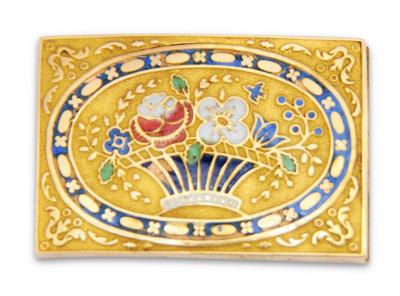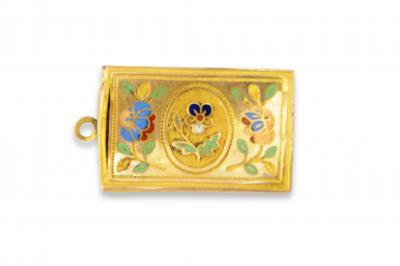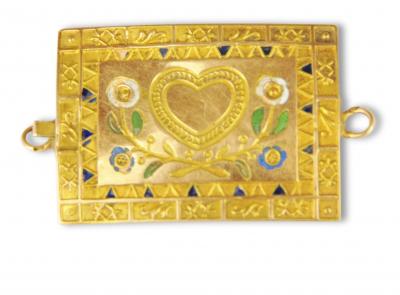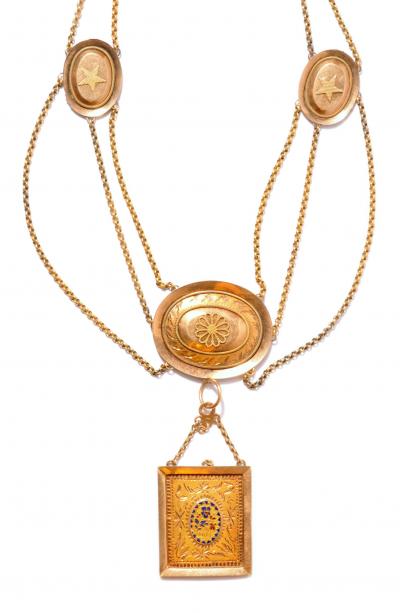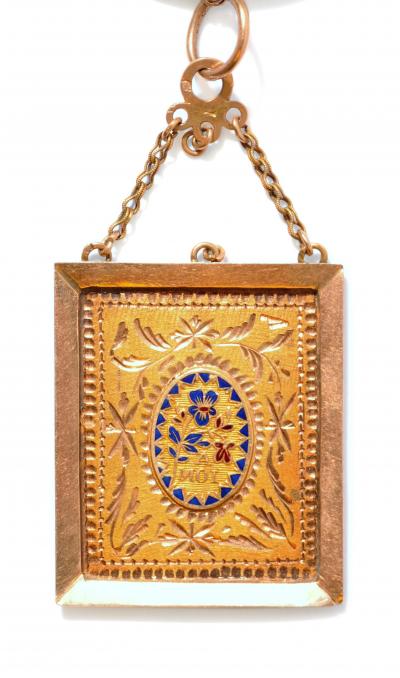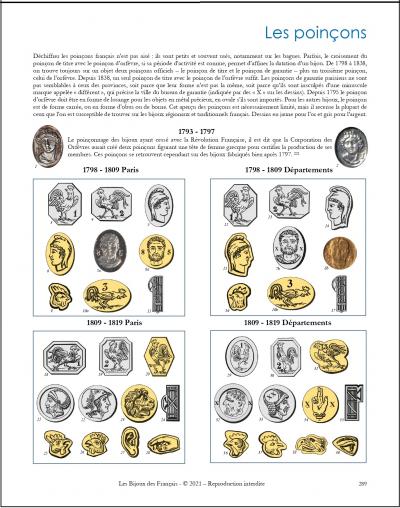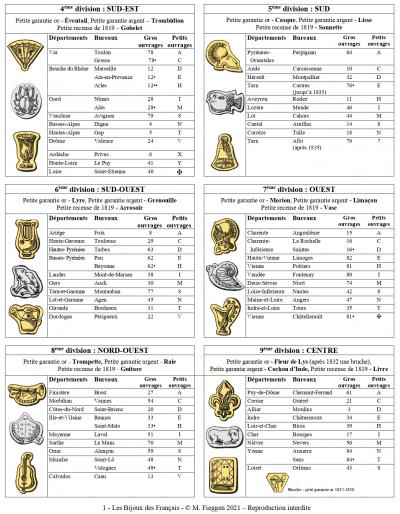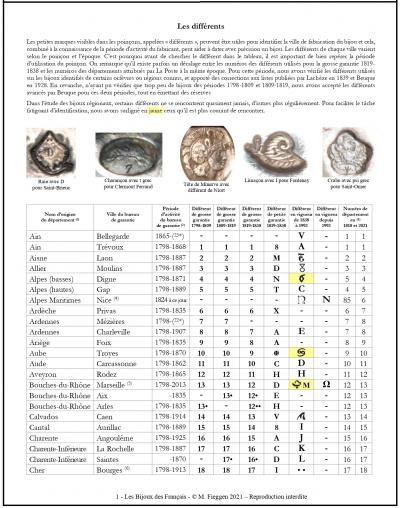Normandy - I

Normandy - crosses, necklaces and pendants
Normandy has for a long time been a very rich province. Regularly raided and then settled by the Vikings, it was able to finance its own invasions and successfully conquered England in 1066. Its wealth came from its fertile lands producing grains, cider, apple brandy, fruits and vegetables as well as dairy products and wood. Some of the earliest French regional jewels originated in Normandy in the mid eighteenth century and they rapidly evolved into numerous and distinct forms. Rhinestones were quickly adopted once they were invented and replaced the cut quartz stones used until then. Diamonds were never used in Normandy, indeed one finds them only in the Flemish regional jewels and in those of the south of France.
The crosses of Normandy
The "bosse" cross - croix bosse
In 1801, Mr. Masson Saint-Amand, prefect (governor) of the department of the Eure, sent to the minister of the interior Jean-Antoine Chaptal, a report on the state of the department in order to demonstrate its progress since the revolution of 1789. "The older women wear quite simple coiffes, whereas the younger women, particularly those who frequent the markets in town, wear very high coiffes mounted like a graceful pyramid above the head, and from which flow long lengths of lace. Almost all, in winter, have capes with hoods in etamine or black camelot, generally lined with white espagnolette. One of their favourite adornements, which in the marriage contract figures alongside the wedding band, is a gold cross with a heart attached to a black velvet ribbon and worn around the neck. The crosses, which are very large in some counties, are raised in bumps or set with quartz stones which are found around Alençon." (1)
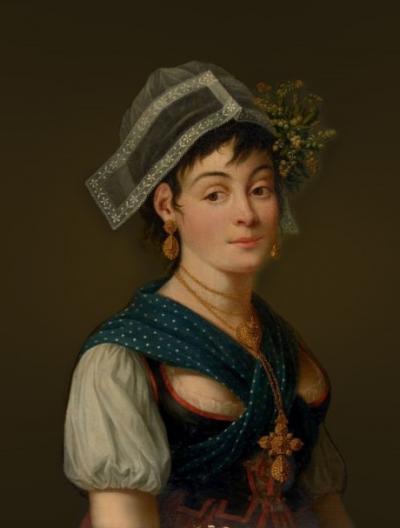
Portrait of young lady in Normandy dress by Jean François Marie Bellier wearing a croix bosse on jaseron chain with ear pendants
click on the images to see them in higher resolution
The "bosse" crosses, sometimes known as "croix à la point de diamant", date from between 1750 and 1820 though re-editions were made towards the end of the nineteenth century. They were often very large (up to 13cm high) and were made in hollow stamped gold or silver, while the slide, or "coulant" was usually decorated with filigree work. The slide is known locally as a "coulant brodé", or embroidered slide. The role of the slide is to enable the height at which the croix bosse is worn to be adjusted without the need to undo the black velvet ribbon knotted behind the neck. The slides generally have the same date mark and maker's mark as the crosses, proving that they were purchased at the same time as the cross, which is not always the case with slides of other crosses. As with many of the larger crosses, the lower segment was hinged to allow for more movement and reduce strain on the intersections. All the bosse crosses have a design of facets however the overall design varies somewhat and there are at least four different types, all illustrated below. Too fragile, the bosse crosses were superceded by the croix drille or croix de pierres with their sparkling quartz or Rhinestones and the croix drille in turn rapidly evolved into the croix de Rouen.
Despite several books mentionning bosse crosses filled with plaster or horse-hair, I haven't come across a single filled one nor is there a single filled bosse cross in the extensive collection of the museum of Martainville. (4) I have to conclude therefore that that if any bosse crosses filled with plaster exist, that they were so modified by their owners to reinforce them, perhaps after a repair, and not by the jeweller who produced the cross. (It's worth bearing in mind that in France it has long been illegal for a jeweller to fill jewellery, the law requires that the client be able to determine the exact gold weight in a piece of jewellery. Even a gold cigarette lighter has to be constructed in such a way that the gold case can be slid off for weighing without the use of tools. The hallmarking agents did however grudgingly, and after the failed prosecution of a jeweller, allow for the cones in the Rouen and drille crosses to be filled so as to reinforce them. It seems highly unlikely however that they would have accepted large bosse crosses to be entirely filled). There have been suggestions in certain references that bosse crosses were made and worn in Brittany and Savoy, however I have seen no evidence of this, apart from some Brittany hallmarks on the later re-editions of these crosses.
The bosse cross type I
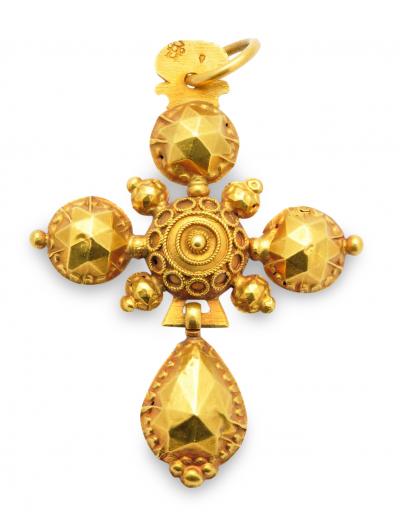
Normandy bosse cross type I in gold, 1762-1768
Double sided and hollow, the decor of the the type I bosse cross is made to simulate facetted stones and to sparkle. The lower part of the cross is articulated. Perhaps the oldest type of boss cross, the type I bosse cross is distinguished by filigree circles around the center. The illustrated example has hallmarks from Caen from 1762 to 1768 while the larger example in the Martainville Museum (60 x 90mm, 9 grams) features hallmarks from Caen and Alençon from 1762 to 1768.
The bosse cross type II
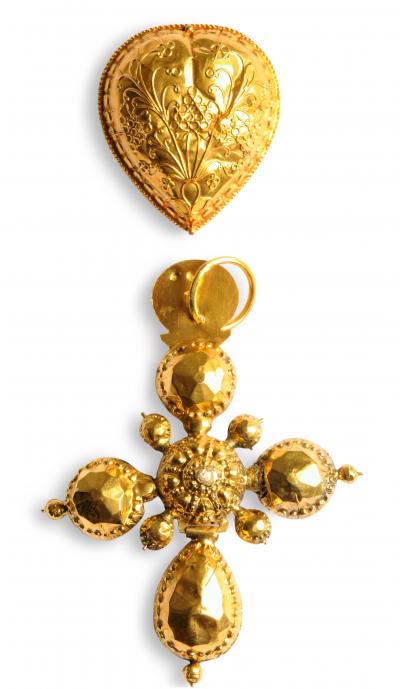
bosse cross in gold, type II
The type II bosse cross is similar to the type I however the centre is decorated with rows of small spheres interspersed with raised elements made to look like facetted gems.
The bosse cross type III
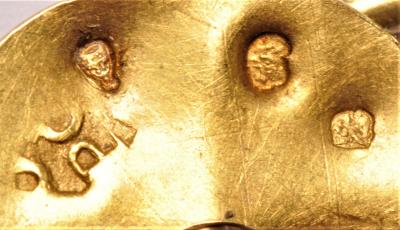
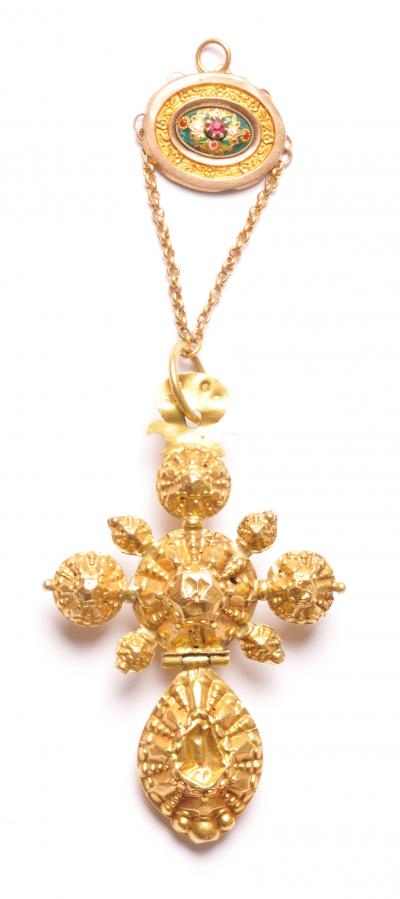
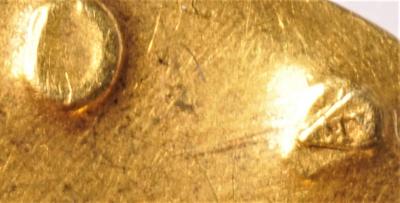
small bosse cross in gold, 1798-1809, type III
Similar to the type I and II crosses, the type III bosse cross has all of it’s sections decorated with lines of small spheres alternating with motifs that ressemble facetted gems. These first three bosse crosses all have a large flat motif at the top shaped like a palmette or fleur-de-lys through which the suspension loop passes and which incorporates all the hallmarks.
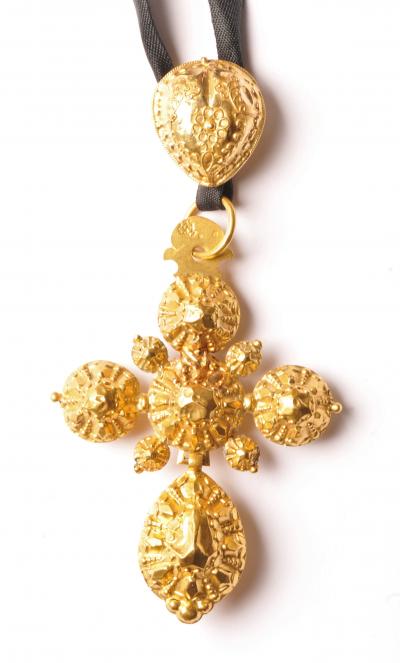
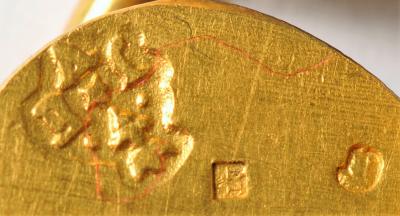
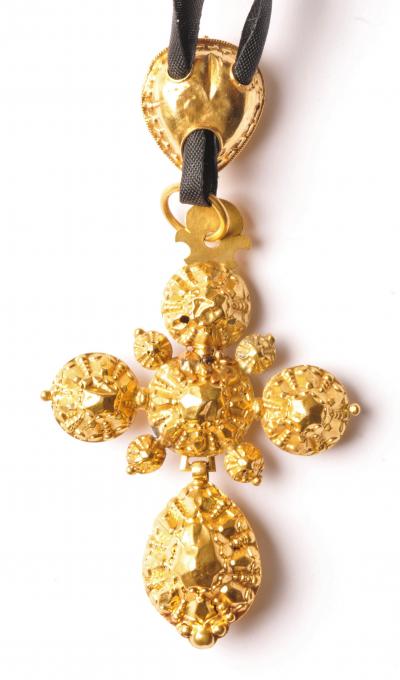
large bosse cross type III in gold with its slide, recto - verso
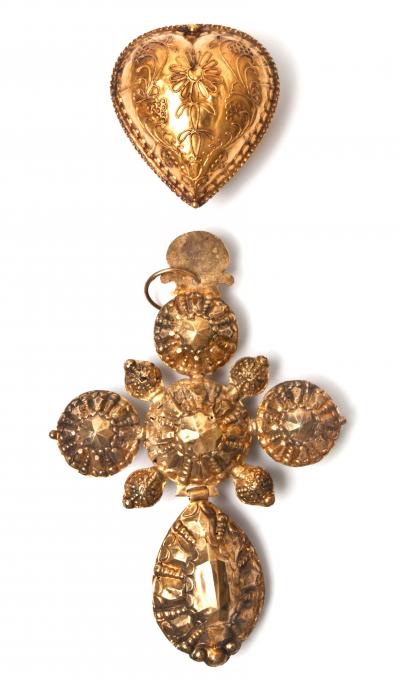
large "bosse" cross with its heart-shaped slide,
stamped gold, type III |
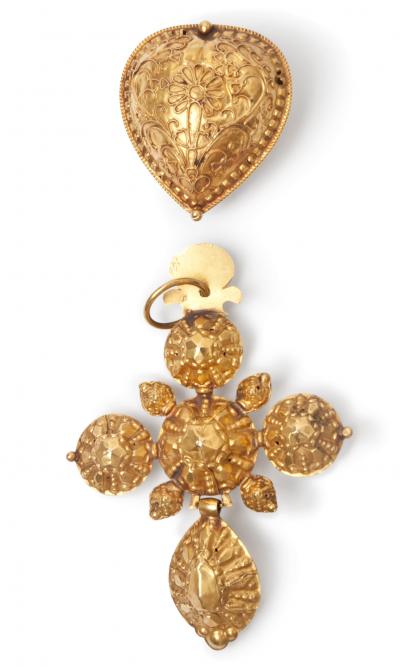
small "bosse" cross with its heart-shaped slide,
stamped gold, type III
|
|
|
|
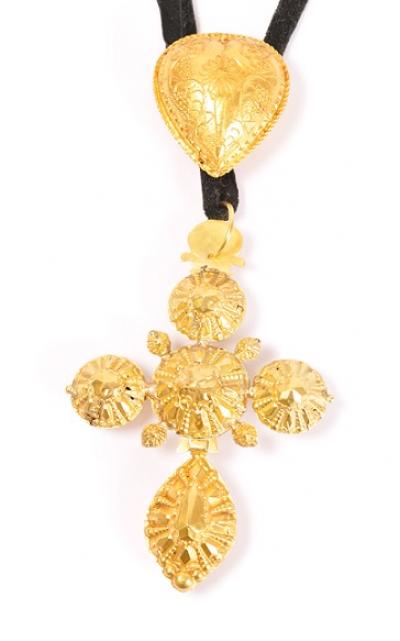
large type III "bosse" cross in stamped gold, with its original ribbon and slide, circa 1800
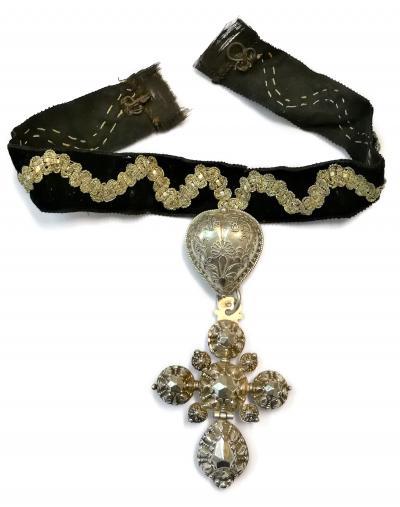
large bosse cross in silver with its orignal sequined ribbon, 1775-1781, type III
|
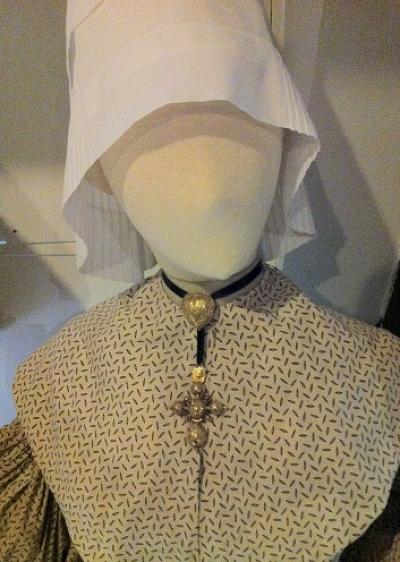
bosse cross in silver on display at the museum
of traditions and normand art, Martainville
|
|
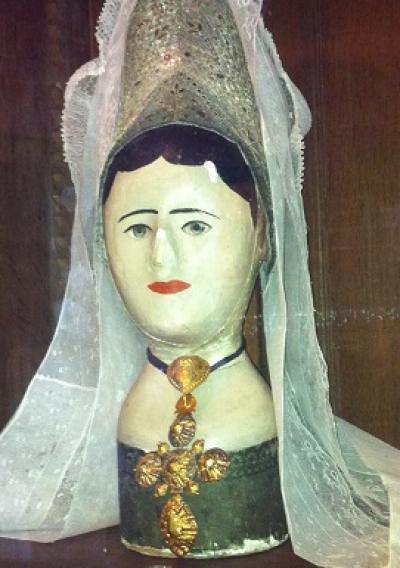
large gold bosse cross displayed on an antique
"marotte" (coiffe holder) in papier maché at the museum
of traditions and normand art, Martainville
|
The bosse cross type IV
On the type IV bosse crosses the slide is fixed directly onto the cross with a metal loop while the fleur-de-lys attachement at the top of the cross has been replaced by an extra section, slightly smaller than the others. (illustrated below). The sections are also joined together with rather long and visible tubes. It is likely that this type of cross is a later re-edition, particularly since the two examples in the collection of the museum des Arts et Traditions Normands in Martainville and the examples illustrated all have hallmarks dating from between 1838 and 1919. The cross in the collection of the National Museum of Arts and Popular Traditions, nowadays in the MUCEM, is in silver and complete with its ear pendants. It has hallmarks from Brest (Brittany) dating it between 1838 and 1919 and was collected by Lionel Bonnemère before 1901. (2)
There was a fashion for wearing French and European regional jewellery in England after the London International Exhibition of 1872, stimulated by the sight of the traditional European jewellery in the various national pavilions. It seems probable that these bosse crosses were re-editions made for the English export market and the French market after 1872 by the same jewellers who supplied English importers with Breton and Normand jewellery. Indeed, the cross and ear pendants illustrated below were found in a fitted English jewel case.
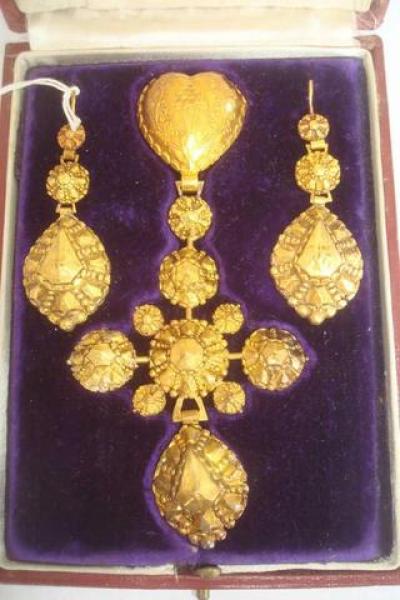
croix bosse type IV with the extra element at the top and the slide fixed directly to the cross.
The presence of matching ear pendants is rare; interestingly the fitted box was made in England.
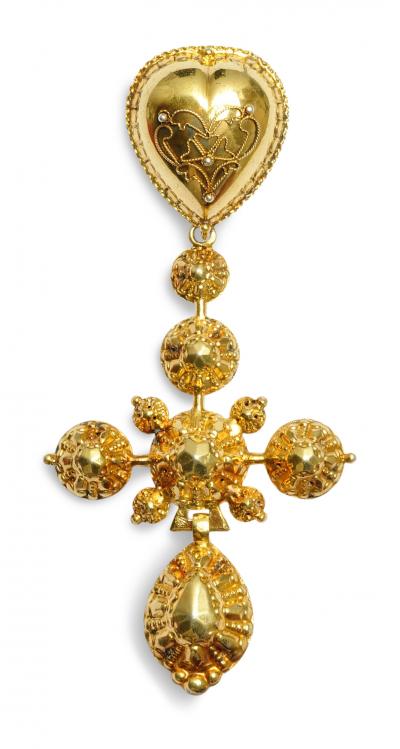
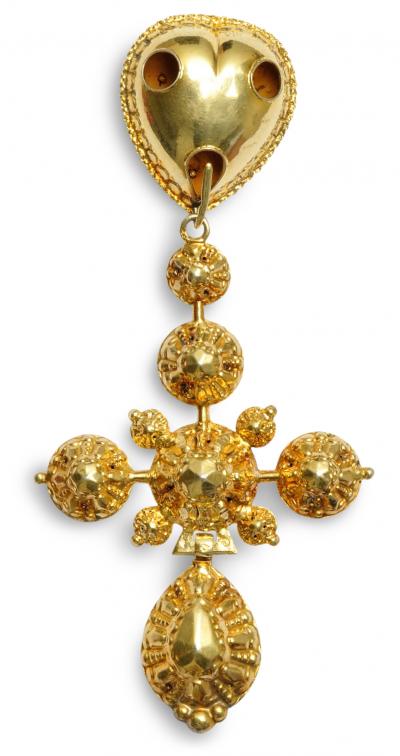
type IV bosse cross in gold-plated silver
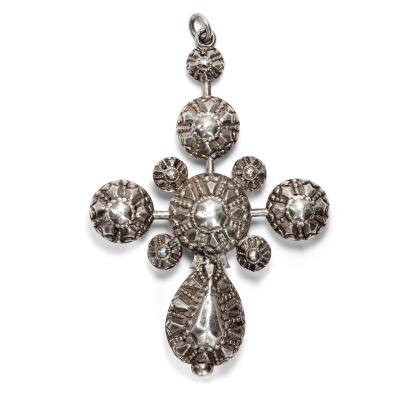
type IV bosse cross in silver
"Normand" jewellery made to match the "bosse" crosses
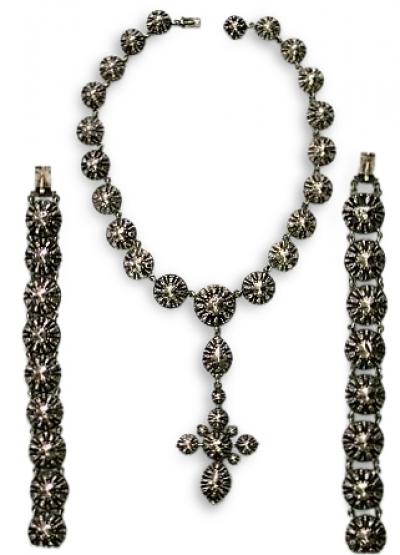
necklace and two bracelets in silver with a type IV croix bosse
Cashing in on the craze for "peasant" jewels stimulated by the international exhibition in London in 1872, jewelery manufacturers surpassed themseves in inventiveness to release new models. The Victoria & Albert museum in London has a fine collection of European peasant jewellery bought during the international exhibitions. In the article by Jane Perry (3) one can see that belts, belt buckles, buttons, bracelets, necklaces and brooches were made with the bosse motif for the English market and yet such jewels were never traditionally worn in France. These re-editions of regional crosses were made to satisty a market quite different to that for the original regional jewels.
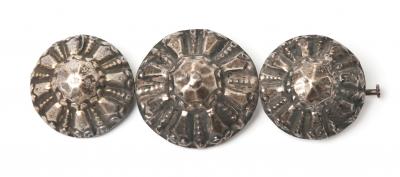
brooch formed with elements of a bosse cross, silver

five silver buttons designed to match a bosse cross
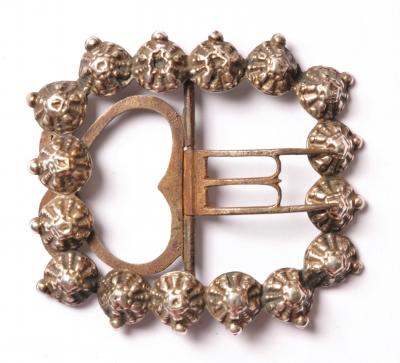
belt buckle in silver and steel
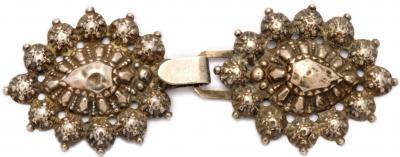
cape clasp, silver, 19th century
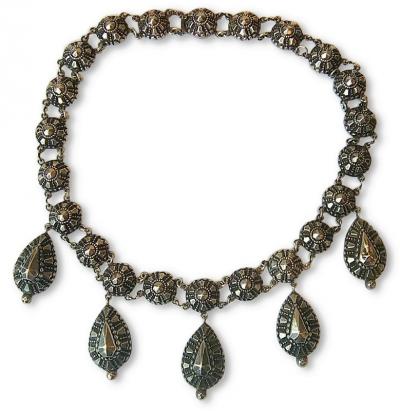
necklace with bosse decor in silver
The croix de pierres or quadrille
The "croix de pierres" crosses were sometimes called "quadrilles", the latter name was particularly used around the town of Saint Lô. Their name comes from the way in which they were made. A metal form is pressed into a piece of flat cuttlefish bone to form a negative impression. The mould thus formed is blackened over a candle flame to protect it and also to smooth out the little lines created by the structure of the bone. Two moulds are fitted together and the molten metal is poured inside. The cross is then polished and corrected with a tool called a "drille" (basically a hand-operated drill, which lead to the crosses being called quadrilles (croix drille). Small cones are soldered on where needed and once the structure is ready, facetted quartz (found in granite quarries near Alençon and called "diamants d'Alençon") or Rhinestones are set in the cones and the background.
|
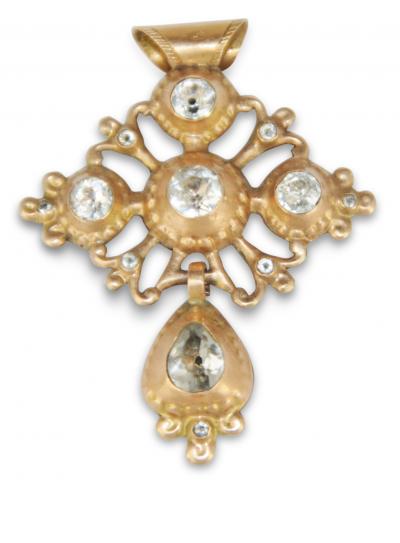
quadtrille or "croix de pierres"
Normandy, gold and Rhinestones
|
|
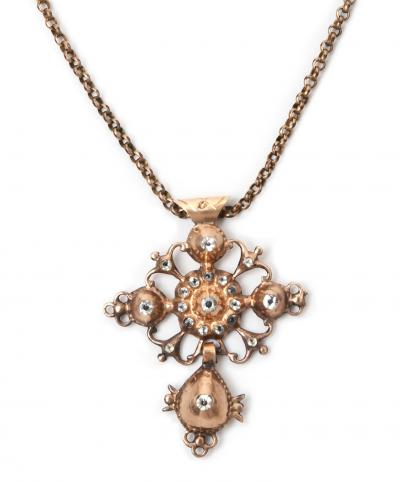
quadtrille or "croix de pierres"
Normandy, gold and Rhinestones |
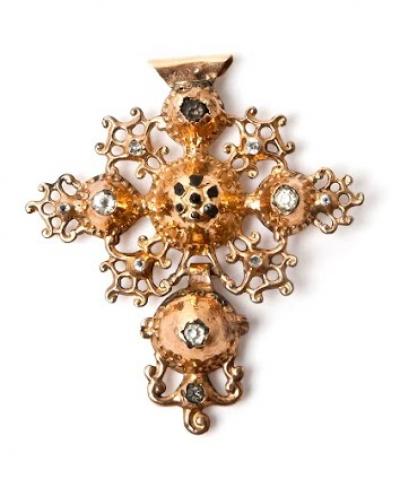
quadtrille or "croix de pierres"
Normandy, gold and Rhinestones |
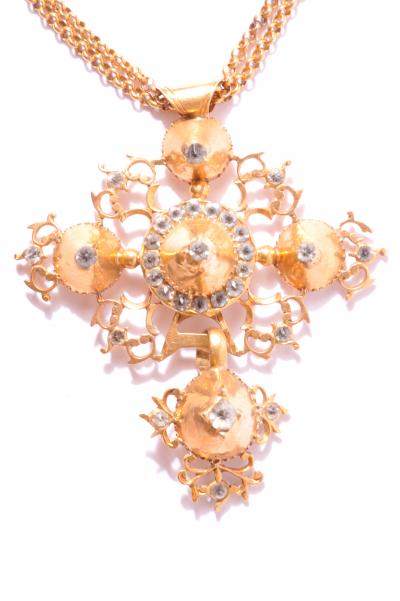
quadtrille or "croix de pierres"
Normandy, gold and Rhinestones |
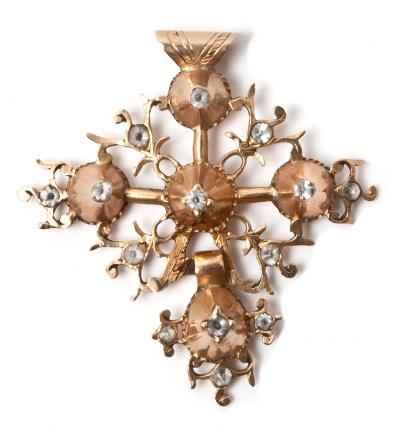
quadtrille or "croix de pierres"
Normandy, gold and Rhinestones |
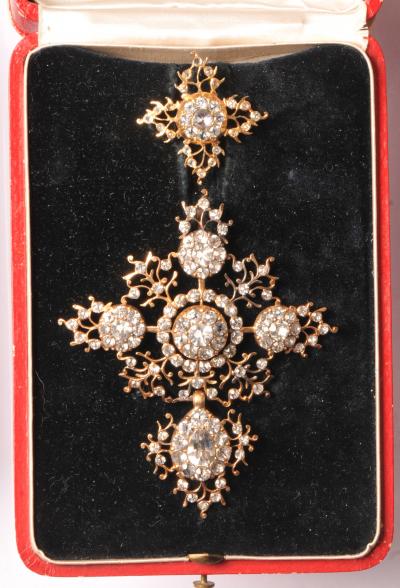
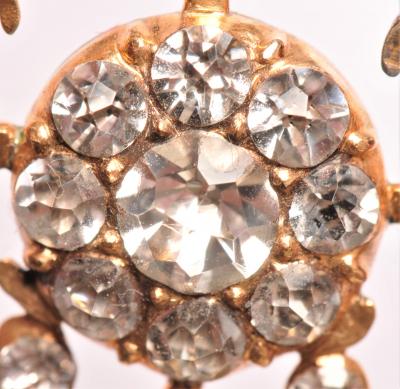
quadtrille or "croix de pierres", Normandy, gold and Rhinestones in its original fitted case
the Rhinestones are facetted with the table pointed
cliick on the images to see them in high definition
If one examines carefully the Normandy crosses, one sees an evolution in shape with time, as the more recent crosses are larger, more intricately worked and set with more Rhinestones. The form of the cross becomes very stylised, to the point that we can barely distinguish a cross shape on the latest Rouen crosses. If we compare the three photos below, we can see the intermediate stage between a highly worked drille cross on the left and a small, early Rouen cross on the right. The most noticable difference between a drille cross and a Rouen cross is that in the latter the jeweller has abandoned the step of casting the rough cross in a mould and has passed directly to cutting the cross out of a sheet of gold and then enhancing it with fret-work.
Look at the drille cross on the left below. You can distinguish a sort of square shape made up of gold openwork between the arms of the cross. It's still visible on the cross in the centre but on the right-hand cross you can see that the openwork has expanded to leave only very small corners of the square visible. And on the Rouen crosses below there is no trace left of the square. The "morphing" of the small drille cross into the spectacular Rouen cross is complete.
|
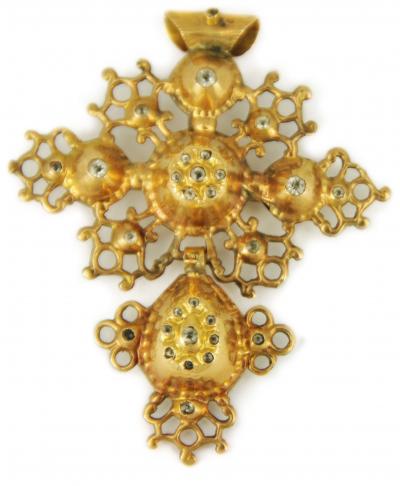
"drille" cross or
"croix de pierres"
Normandy, gold and Rhinestones
|
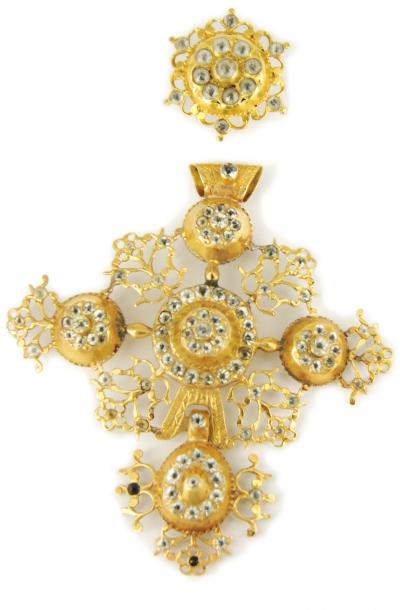
early Rouen cross with
its slide, Normandy,
gold and Rhinestones |
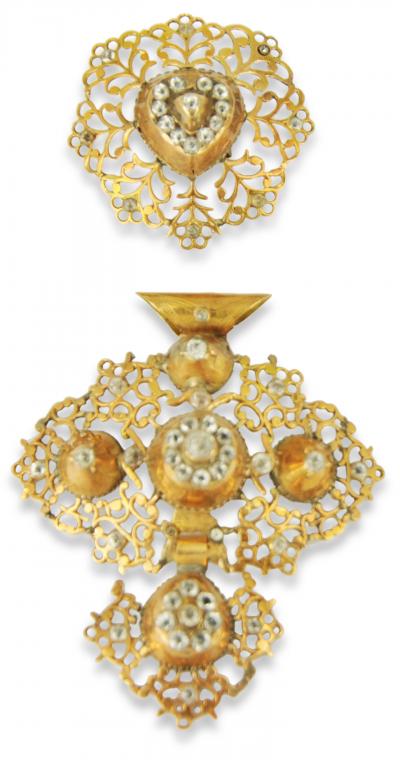
Rouen cross with
its slide, Normandy,
gold and Rhinestones |
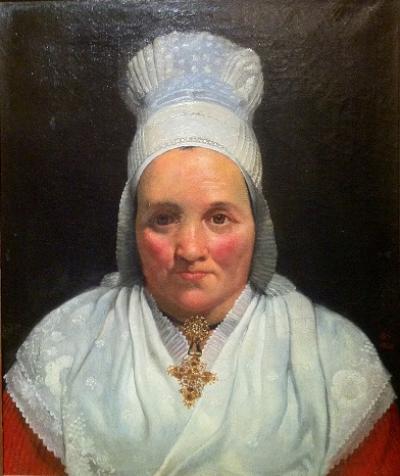
drille cross worn by a woman near Coutances, 1826
musée des traditions et arts normands, Martainville
The Rouen cross - croix de Rouen
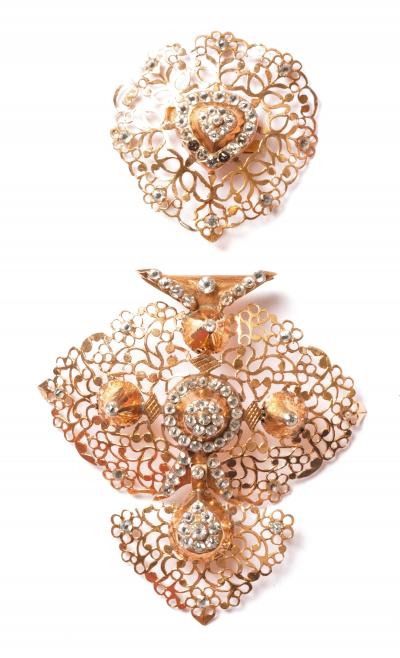
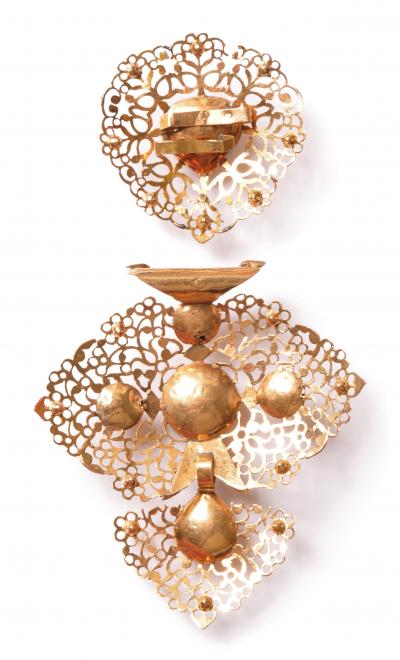
Rouen cross with its slide, Normandy, gold and strass (Rhinestones)
Visitors to Rouen between 1820 and 1880 were astonished to see women wearing their enormous Rouen crosses, unique to Normandy. Made of slightly convex sheets of gold pierced with fretwork, they were set with a multitude of strass stones, never diamonds. The crosses were normally worn on a black velvet ribbon, but one sometimes sees them hung from a "jaseron" chain. Note how the croix de Rouen becomes more and more stylised with time. Today, antique Rouen crosses are found pretty much all over France, suggesting that they must have been very popular souvenirs for tourists visiting Normandy after 1870.
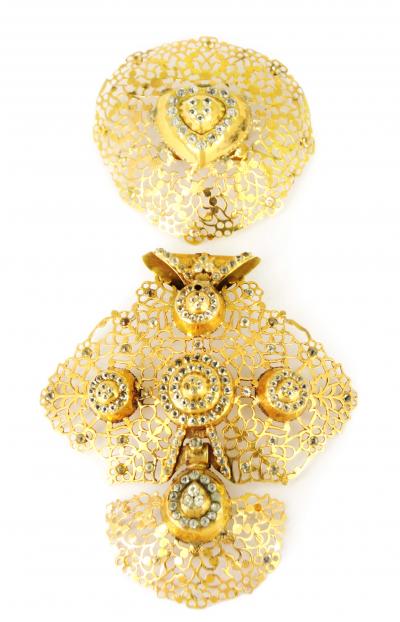
Rouen cross with its slide, Normandy,
gold and strass (Rhinestones) |
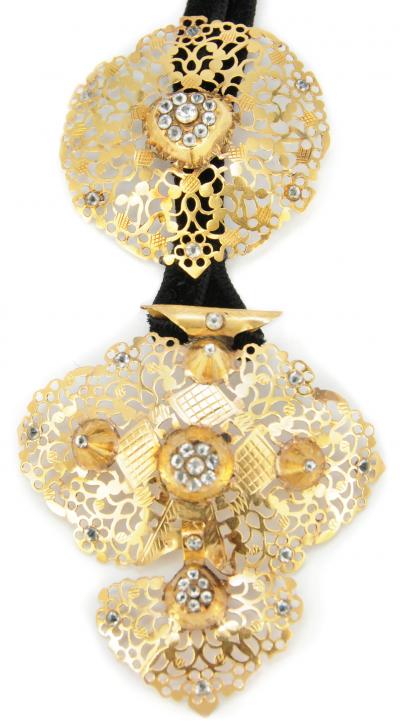
Rouen cross with its slide and ribbon,
Normandy, gold and Rhinestones |
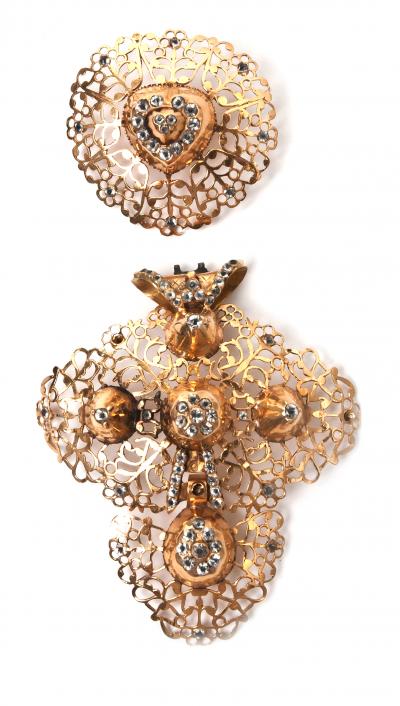
Rouen cross with its slide, Normandy,
gold and strass (Rhinestones) |
|
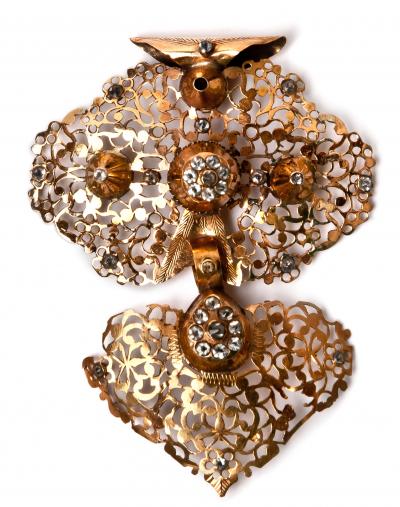
Rouen cross, Normandy,
gold and Rhinestones
|
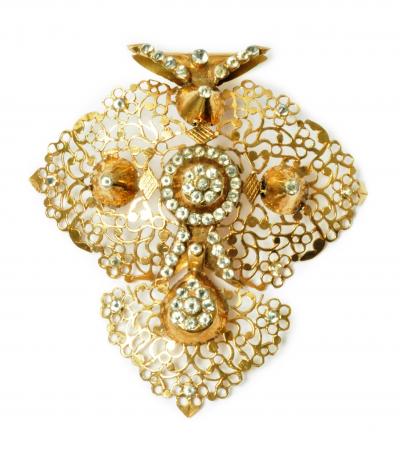
Rouen cross, Normandy,
gold and Rhinestones
|
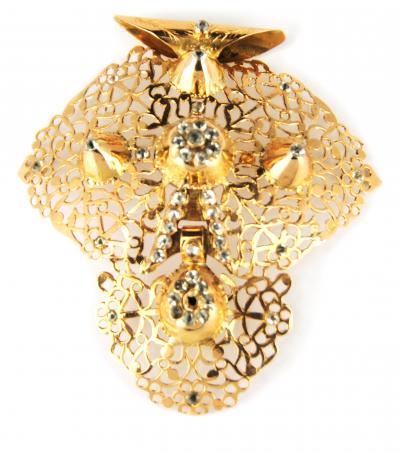
Rouen cross, Normandy,
so stylised it's difficult to see a cross! |
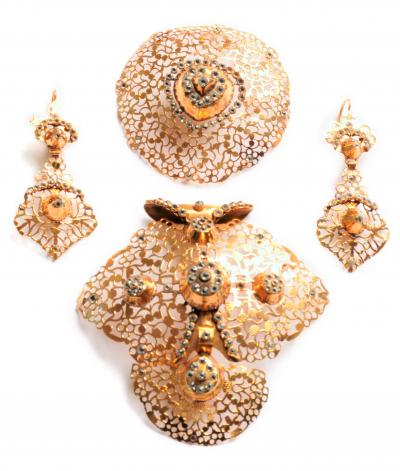
ensemble consisting of a Rouen cross with its slide and ear pendants, Normandy, gold and Rhinestones 1819-1838
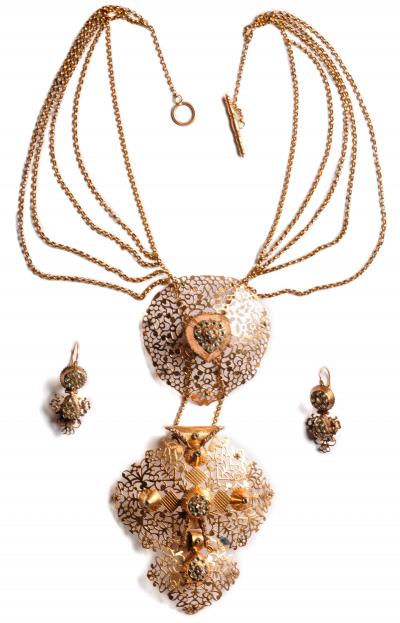
ensemble consisting of a Rouen cross with its slide and ear pendants, Normandy,
gold and Rhinestones 1798-1809
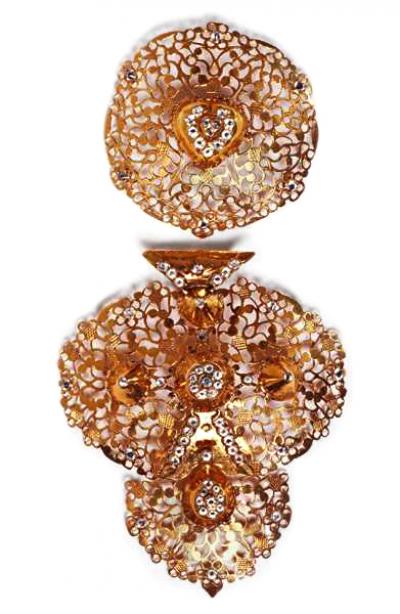
Rouen cross with its slide, Normandy, gold and Rhinestones
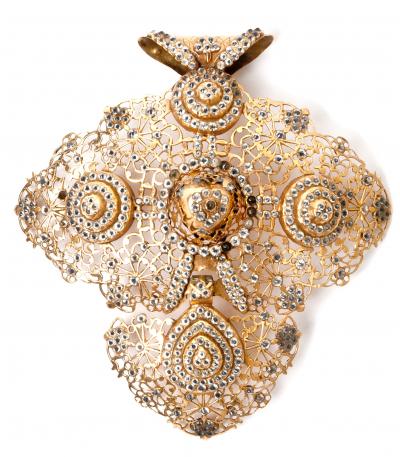
Rouen cross, gold and Rhinestones
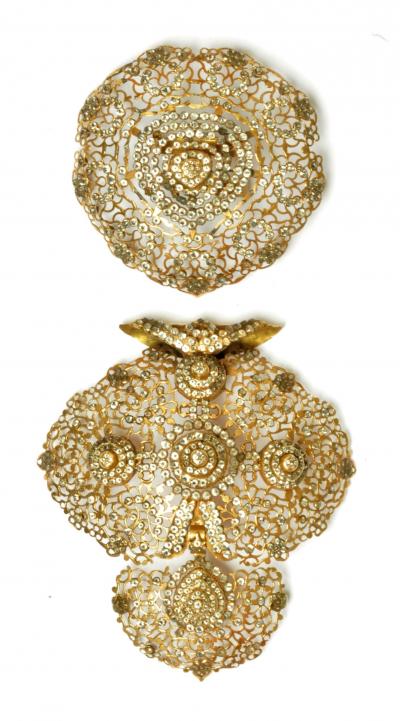
Rouen cross with its slide, Normandy, gold and Rhinestones
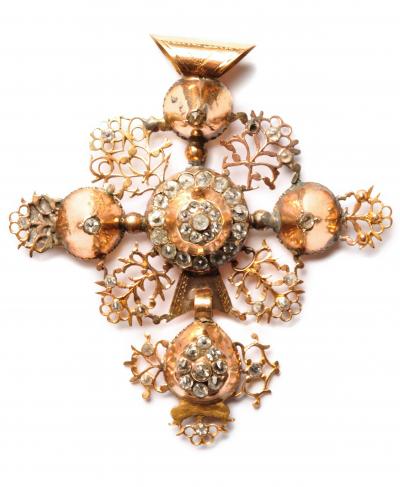
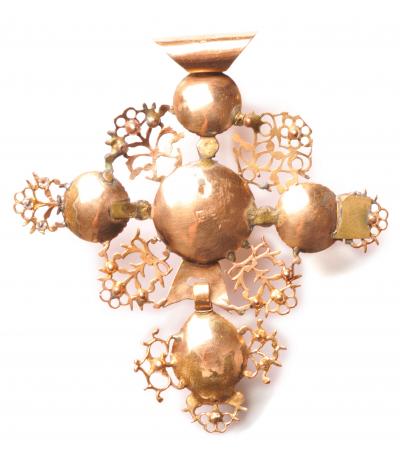
Rare Rouen cross made in gold-plated brass. Very few gold plated crosses have survived
The Saint Lô cross - croix de Saint Lô
The Saint Lô crosses were worn in other parts of Normandy than just Saint Lô and are almost always made in silver set with Rhinestones or, for the older ones, with slightly smokey quartz from the granite mines near Alençon. Some rare enxamples are found in gold. Their name comes from their original site of production, (though later they were also made in other towns in Normandy), rather than their area of adoption. They were worn mainly in the southern half of Normandy, which was less prosperous thn the north and where the gold crosses almost never caught on. Slides are rare on the Saint Lô crosses and where found usually have different hallmarks, suggesting they were purchased later or had been replaced. The Saint Lô cross should not be confused with the "drille" cross because the five main Rhinestones are larger, the design is different and the suspension loop is hidden behind the cross unlike the prominent triangular loop on the "drille" cross.
Normally the black spots in the middle of the rhinestones indicate that the culet (point) of the stones have been cut, indicating that the stones are old. I have recently discovered however that on some antique regional jewels the black spots have actually been painted on the points of the stones. These jewels were certainly made between 1870 and 1900 for the tourists who eagerly sought regional jewels, and especially the older ones.
|
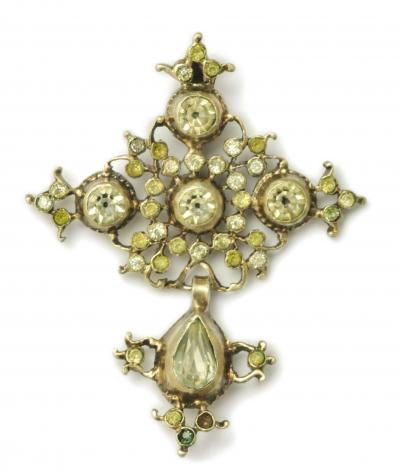
Saint Lô cross
Normandy, silver and Rhinestones
|
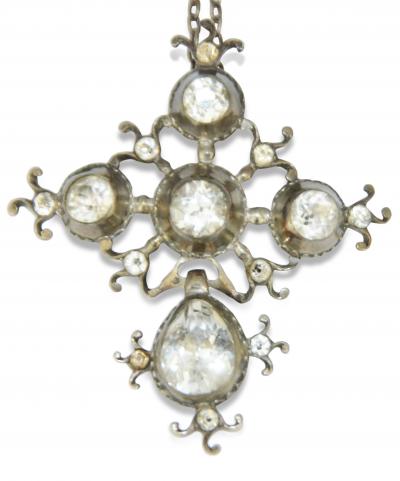
Saint Lô cross
Normandy, silver and Rhinestones
|
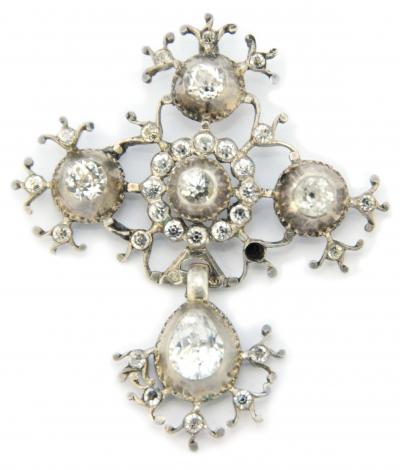
Saint Lô cross
Normandy, silver and Rhinestones
|
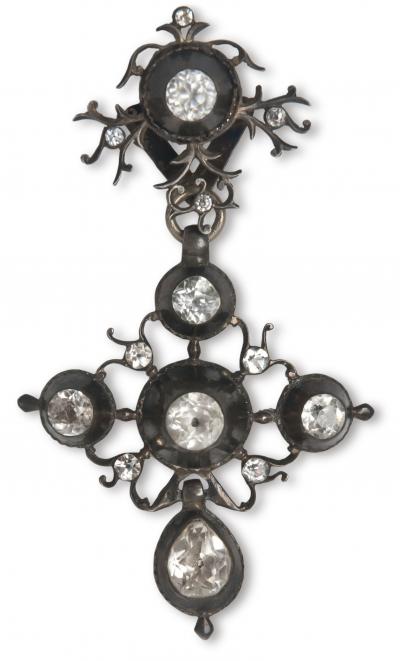
croix de Saint Lô with its slide
silver and Rhinestones
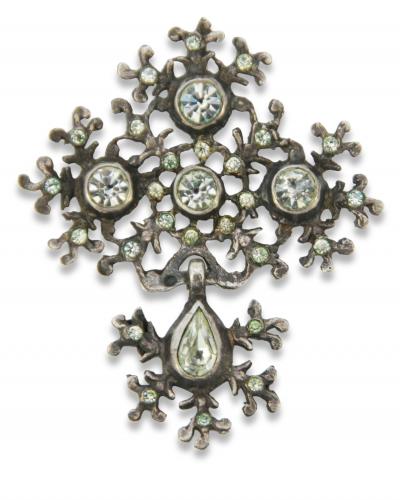
Saint Lô cross (modern)
silver and Rhinestones |
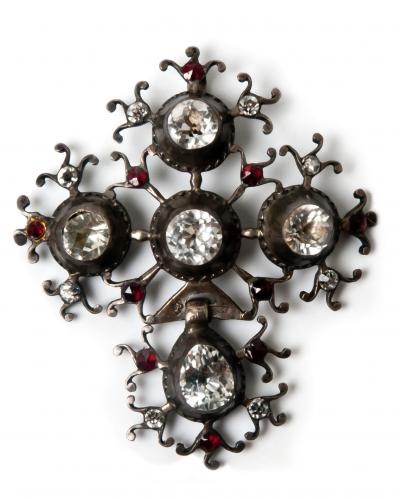
Saint Lô cross in silver
with white and red Rhinestones |
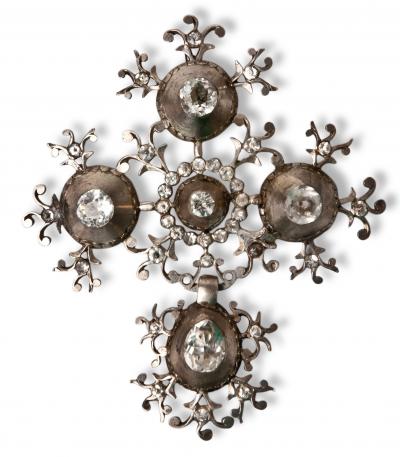
Saint Lô cross
silver and Rhinestones |
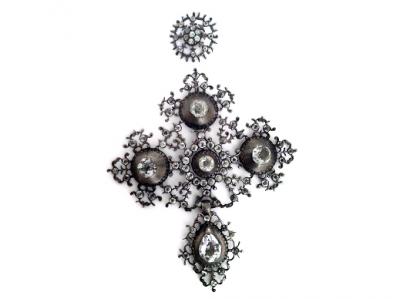
croix de Saint Lô with its slide, silver and Rhinestones
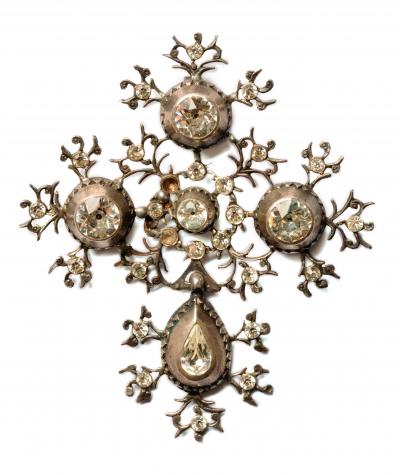
croix de Saint Lô in silver and Rhinestones
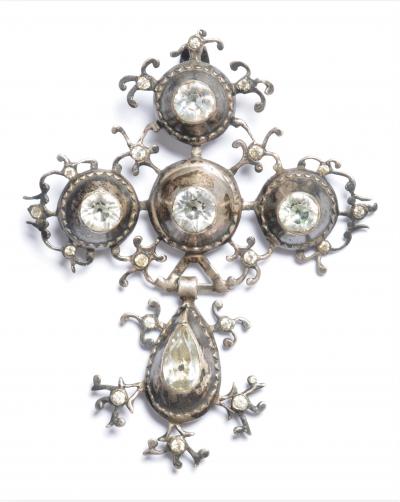
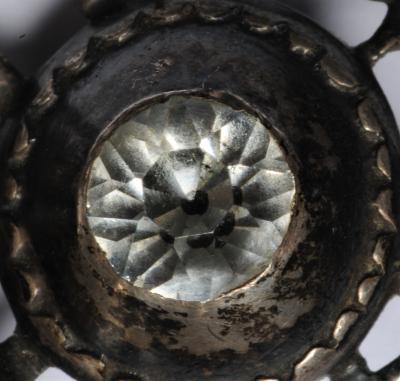
Saint Lô cross in silver and Rhinestones where the polished-off culets have been imitated by black painted spots on the tip
At the end of the 19th century, the Parisian jewellers making French regional jewellery would do their best to make them look as antique as possible. Because on genuine antique diamonds and Rhinestones the bottom point of the stone, the culet, was polished off, in order to make the modern cut stones they were using look like the antique ones, the jewellers would paint a black spot on the culet of the stone.
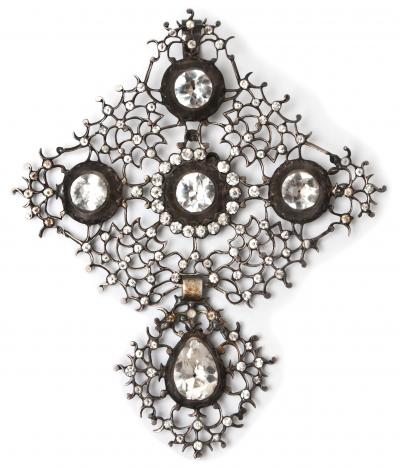
Large Saint Lô cross in silver and Rhinestones, early 19th century
This cross was found within its orignal box, which had no place for a slide |
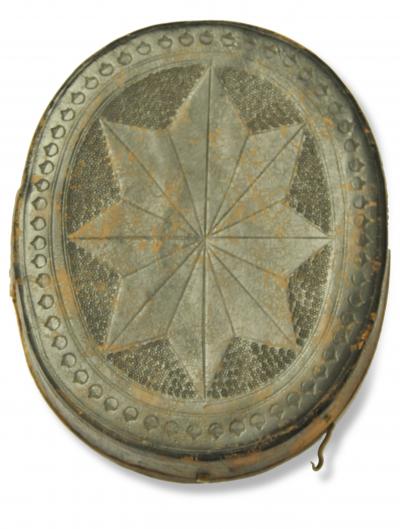
Original jewel box for Saint Lô cross shown at left. Cardboard and leather
|
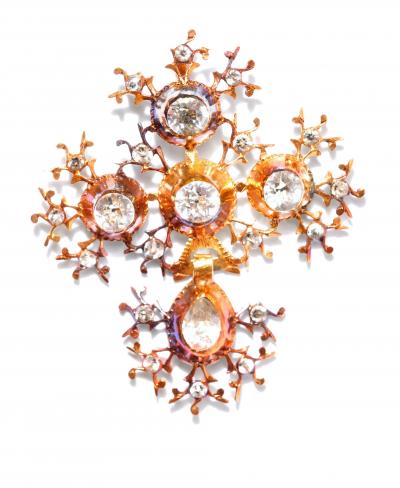
Saint Lô cross, Normandy, gold and Rhinestones
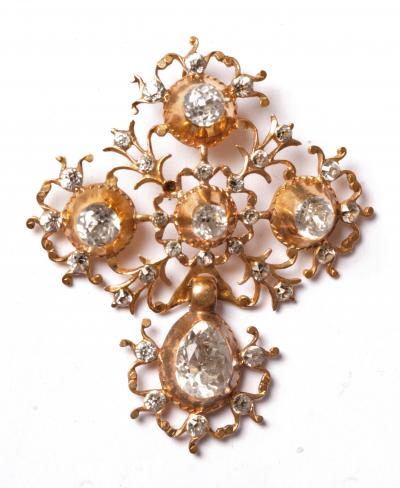
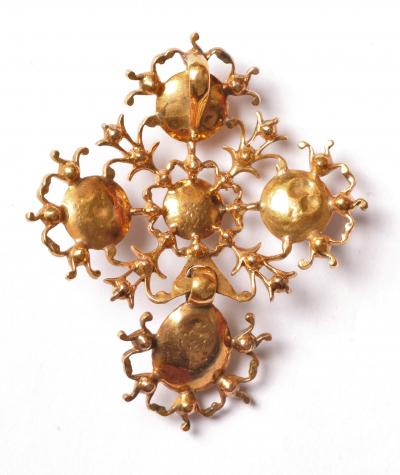
Saint Lô cross, Normandy, gold and Rhinestones
The Caen cross
The Caen cross is very similar to the Saint Lô cross, however one observes a more pronounced square shape to the openwork around the centre of the cross, similar to the drille cross, and the slide is shaped like a ribbon bow and is decorated with strass. The Caen cross is garnished only with small Rhinestones, unlike the Saint Lô cross which has large central stones. It differs from the drille cross in that it doesn't have the large V shaped hinge.
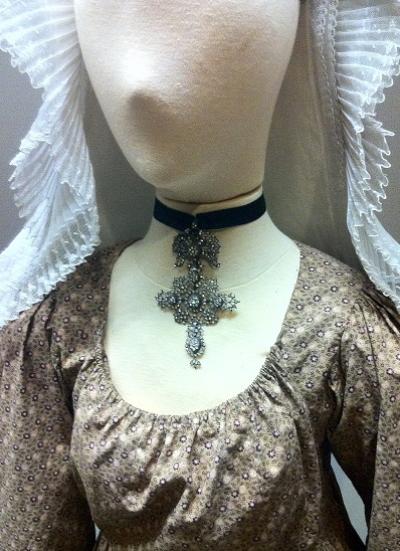
Caen cross in silver and strass exposed at the
musée des traditions et arts normands, Martainville, 76
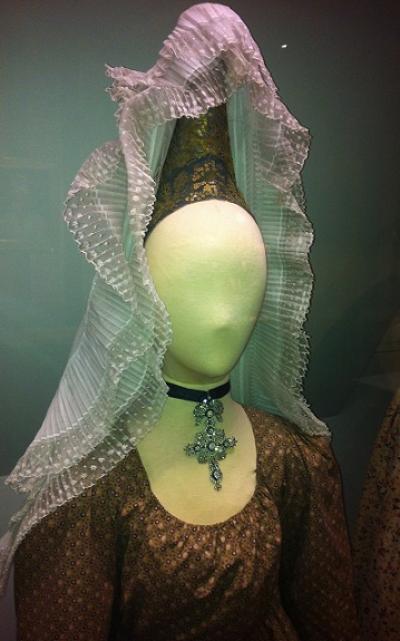
Caen cross in silver and strass exposed at the
musée des traditions et arts normands, Martainville, 76
The "papillon" or Flemish cross
This type of papillon (butterfly) cross, although made in Flanders, Belgium, was also worn in the north of France down to Normandy between 1770 and 1840. (It should be remembered that Belgium was a French province between 1793 and 1815). In Belgium they are known as "croix à la Jeannette". I have yet to come across one found in France with legible hallmarks which would help in determining its exact town of production, though it is certain they were produced in Flanders. They are made of silver set with rose cut diamonds and have a thin layer of gold on the back to prevent them from blackening clothes. Although some references have attributed these crosses to the Provence region, they are in fact quite different in aspect to the true papillon crosses of Provence.
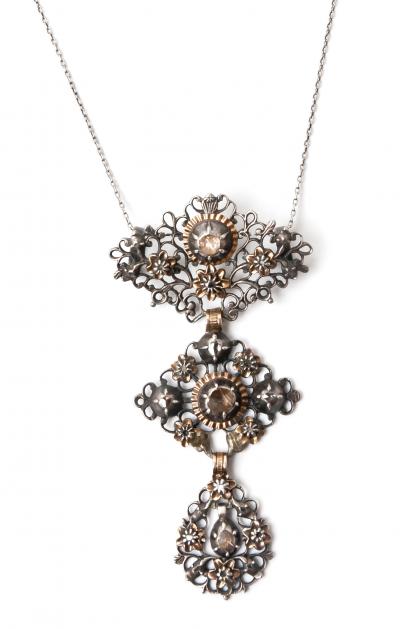
papillon cross, c1800-1840
in gold-backed silver & diamonds |
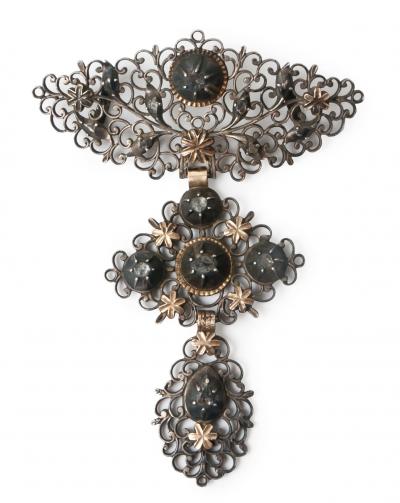
papillon cross, c1800-1840
in gold-backed silver & diamonds |
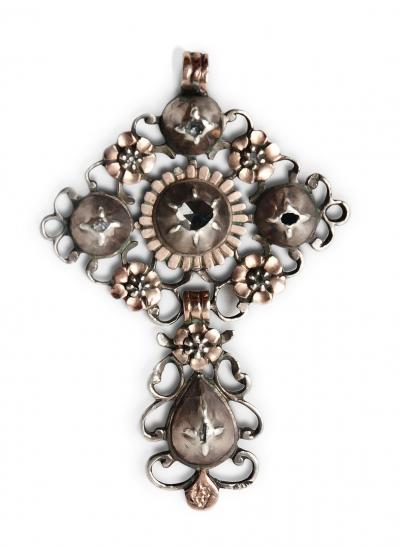
papillon cross
in gold-backed silver & diamonds |
Necklaces
Slave collar or necklace - le collier esclavage
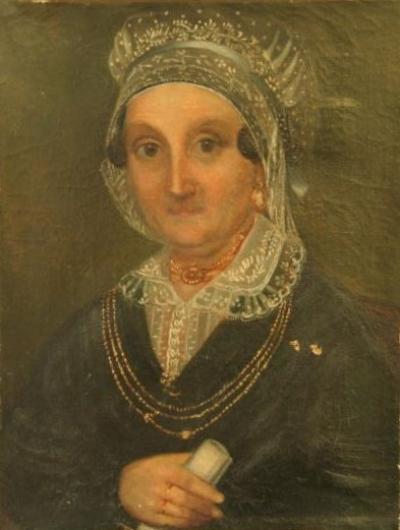
collier esclavage or slave collar
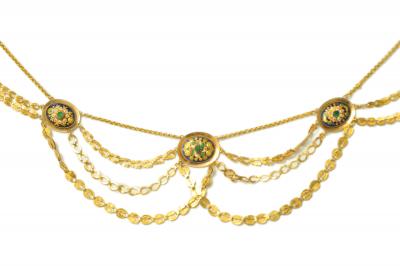
gold slave collar (collier esclavage) from Normandy set with Bressan enamel plaques
click on the photos to enlarge them in high resolution
|
Just like the other jewels from Normandy, the spectacular Collier Esclavage had a very simple origin which evolved rapidly as the wealth of Normandy increased. By 1800, women in Paris were already wearing neclaces made of several plaques or cameos joined by gold chains. In Normandy the necklaces evolved in parallel. There was initially a simple neck-chain of tressed horsehair fastened with a small flat gold clasp. The plaque-shaped clasp gradually became larger and more decorative, sometimes being enameled with a pansy motif. The horsehair was replaced by gold plated or solid gold chain and when the plaque became more decorative it started being worn at the front rather than behind the neck.
chain of tressed horsehair with gold catch
|
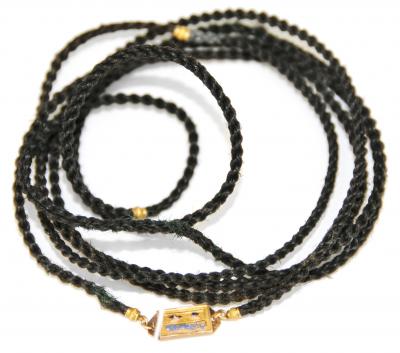 |
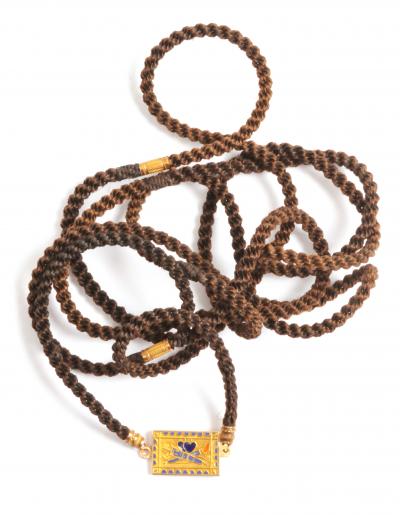
long chain made of hair with enamelled gold catch
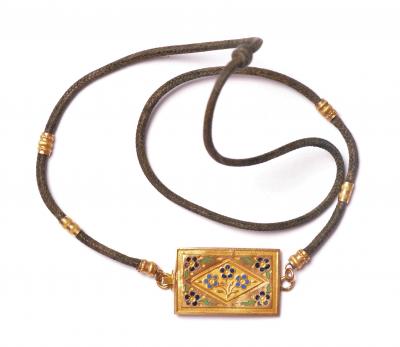
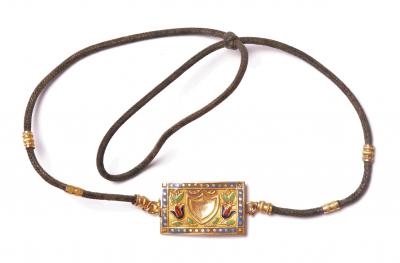
short necklace made of hair with enamelled gold catch
As the plaque became larger it became necessary, in order to stop it from turning, to solder two chains on each side of it which then re-joined the main chain. The author Jules Barbey d’Aurevilly, in his book “L’ensorcelée” published in 1850 described the esclavage as “….a jewel generally made of two bracelets joined by a small chain”. (2)
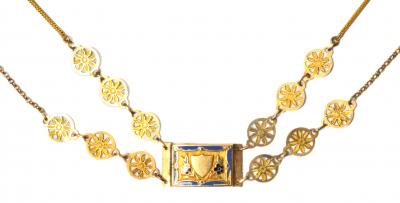
'esclavage' (slave) necklace, Normandy, gold and enamel. note how the clasp is worn at the front;
one can understand how Jules Barbey d’Aurevilly could describe it as
"two bracelets attached by a small chain".
This would indeed be a succinct way of describing the early esclavage necklace and it gives a possible explanation for the name: slaves were often hobbled with a metal chain or cuff around each wrist or ankle attached together with a short length of chain. It has been suggested that the collier esclavage or slave collar took its name from the state of submission in which a woman found herself once married. It's unlikely that the women of the time would have agreed to a name for one of their prized ornaments suggesting their enslavement. In his monumental work "La bijouterie français du 19ème siècle", Henri Vever never used the term "collier esclavage", only "collier", (necklace) or "collier monté en esclavage" (necklace mounted in slave). It's very possible that the term derives from the fact that the chains are intertwined between each other, each chain is a prisoner of its neighbouring chain, much as slaves had their chains looped through those of their neighbour. (3)
The single plaque soon became three plaques, even five, with as many as five chains, sometimes very decorative and even enameled, joining them. The necklace ceased to open from the front and a catch was fitted to the back. It is thought that an extra plaque or a set of links was offered to a man's wife to celebrate each birth of a child.
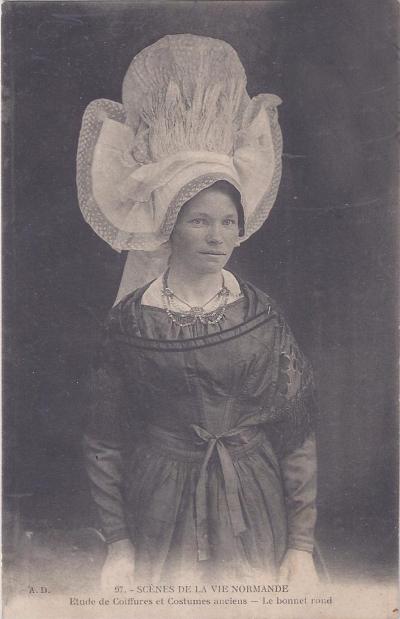 |
Jewelers in Normandy would often assemble the necklaces to order by using enameled plaques which generally came from Bourg en Bresse or Paris as well as fancy chains bought by the metre from Parisian manufacturers. I’ve handled over a hundred esclavage necklaces over the last thirty years and I don't think I've ever seen two the same.
The collier esclavage from Normandy was generally made with oval plaques while those from Auvergne, the other main area where they were worn, had rectangular plaques. The collier esclavage reached its peak in popularity around 1830 - 1840 before evolving into the more discreet colliers draperie (draperie necklaces, see section French Family Jewels).
postcard showing Normandy folk-dress with slave collar necklace
|
It has been stated in some references that the collier esclavage could cost as much as a thousand francs, or even the price of two cows. This is patently untrue. While the collier esclavage in gold was certainly an expensive piece of jewellery, a thousand francs, the equivalent of ten thousand Euros today, is impossible. They are very lightly made and usually contain between five and twenty-five grams of eighteen carat gold. A gold Napoléon containing 6.4 grams of twenty-two carat gold circulated at a face value of twenty francs until the First World War and the labour cost of transforming one or two Napoléons into a necklace is far less than a price of a thousand francs would suggest. Marguerite Bruneau in her invaluable reference Histoire du costume populaire en Normandie mentions a collier esclavage of fifteen grams valued at thirty-two francs in 1830 at Saint Lô. (4)
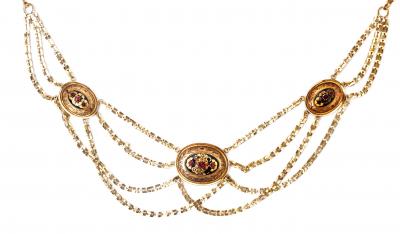
'esclavage' (slave) necklace,
Normandy, gold and Bresse enamels |
|
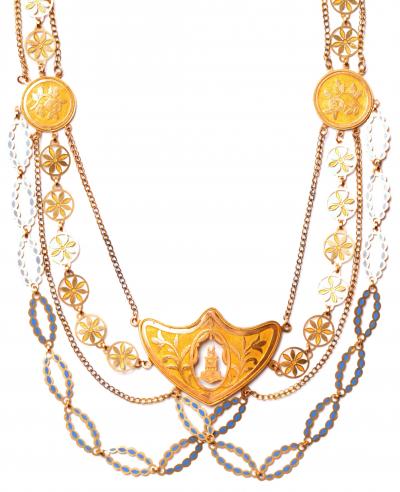
Normandy esclavage necklace with a motif of two hearts burning on an altar, gold and blue enamel

détail of Normandy esclavage necklace with a motif of two hearts burning on an altar, gold and blue enamel, enlarged 200%
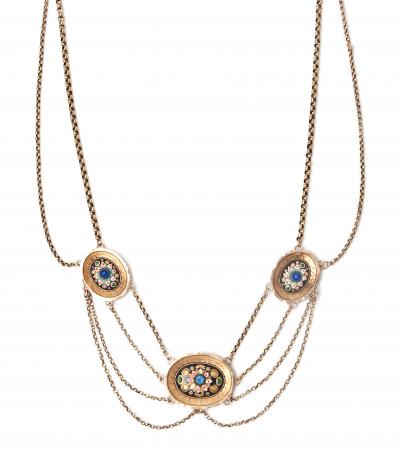
'esclavage' (slave) necklace, Normandy, gold and Bresse enamels
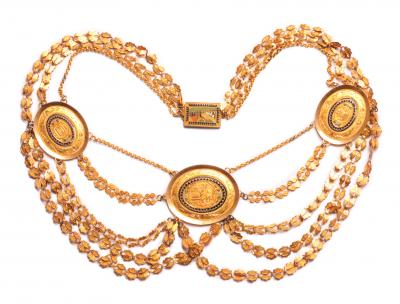
'esclavage' (slave) necklace, Normandy, gold and enamel
motif of a dog, to symbolise fidelity as well as two burning hearts on an altar
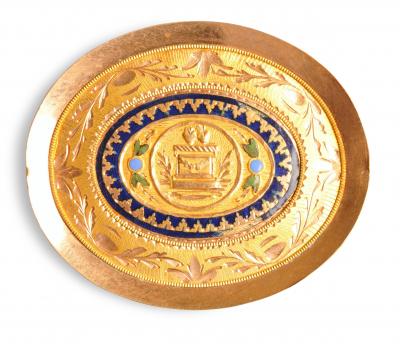
detail of the central plaque |
|
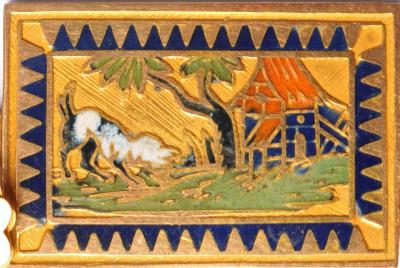
detail of the catch |
|
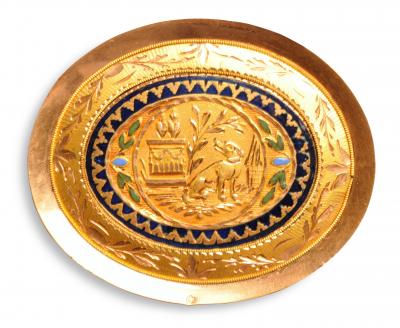
detail of a side plaque |
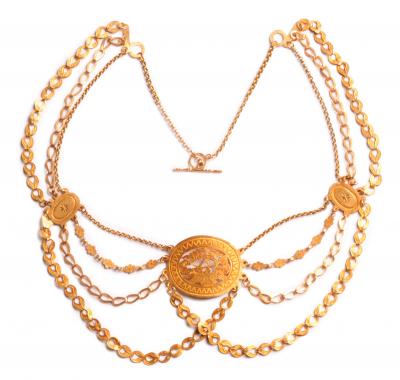
'esclavage' (slave) necklace, Normandy, gold and enamel, Rouen 1809-1819
motif of two doves, a popular marriage symbol
click on the photos to enlarge them in high resolution
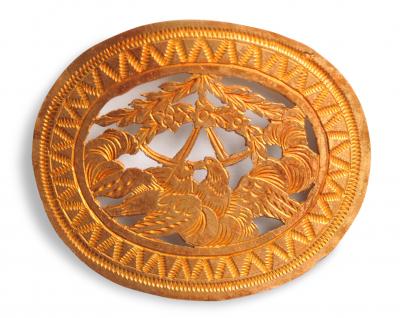
detail of the central plaque, 200%
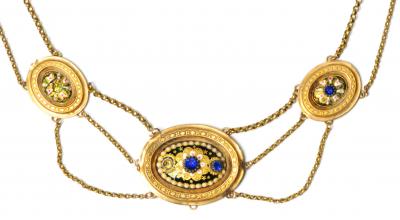
'esclavage' (slave) necklace, Normandy, gold and Bresse enamels
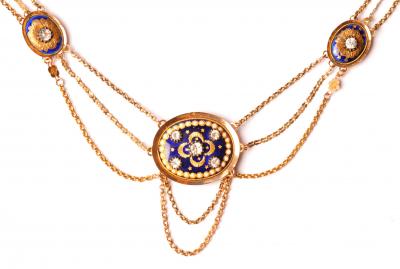
'esclavage' (slave) necklace, Normandy, gold and Bresse enamels
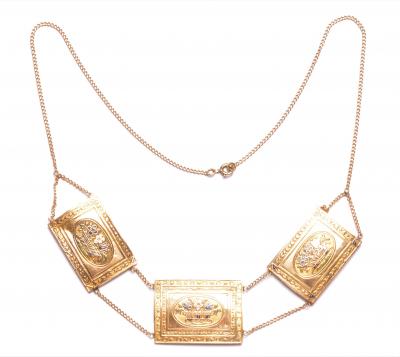
necklace made of three catches, gold and enamel
click on the photos to enlarge them in high resolution
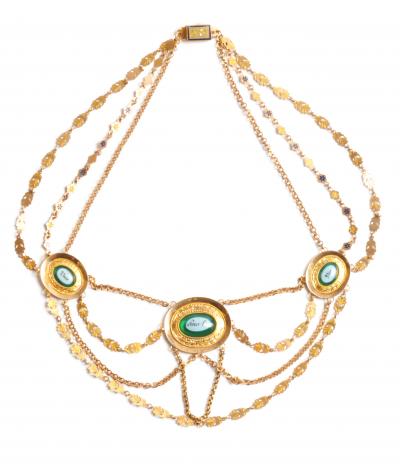
'esclavage' (slave) necklace, Normandy, gold and enamels
the text reads "Unis pour la vie"
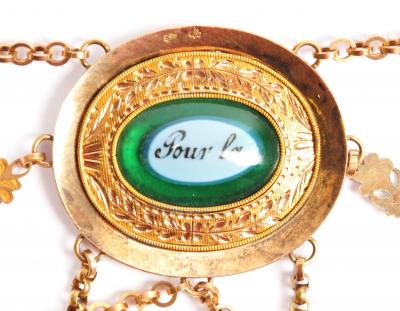
detail of central plaque
|
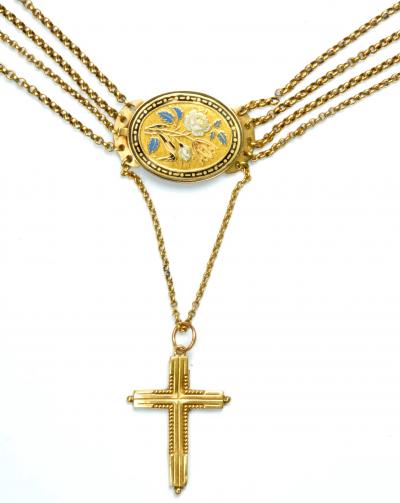
'esclavage' (slave) necklace, Normandy,
gold and enamel; the central plaque is a clasp
|
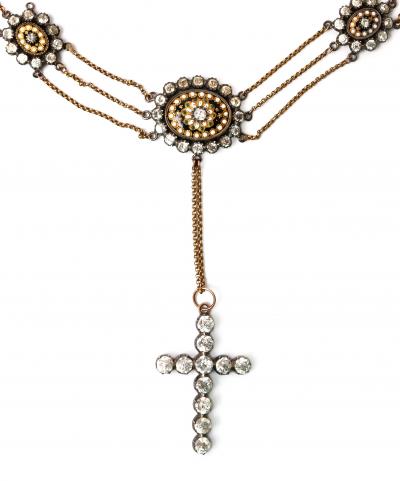
'esclavage' (slave) necklace, Normandy,
gold, strass and Bresse enamels
|
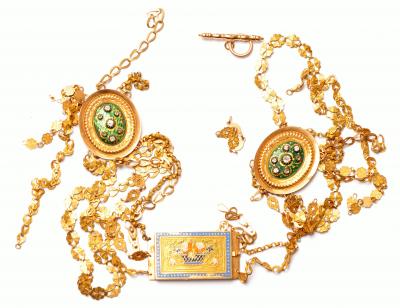
'esclavage' (slave) necklace, Normandy, gold and Bresse enamels
Usually given as engagement presents, esclavage necklaces sometimes suffered during family disputes.......
The colliers esclavage were often fastened with an large enameled clasp and one sometimes finds simple chains with one of these large enameled clasps as their sole decoration. It is suggested that these are the early forerunners of the elaborate esclavages or that they were worn in lieu of esclavage necklaces by less wealthy women; both of which explanations are certainly true. However, is it not also possible that these chains were offered to some women at their marriage with the intention to add the requisite plaques and chains to form a real collier esclavage with the birth of each child and as the finances of the family improved? A change in fortune for the worse or the absence of children born could explain why some of them have reached us in their unaltered state. Some of the plaques even have some extra holes ready to fit additional chains.
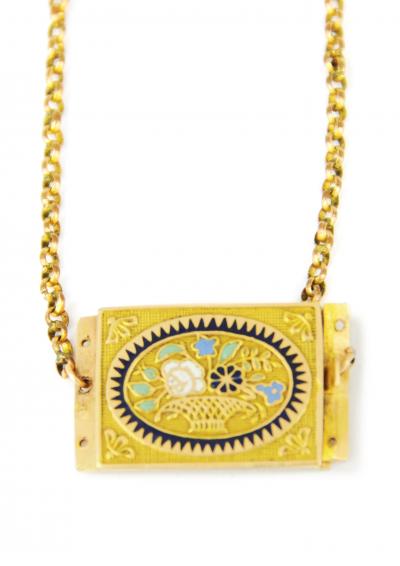
Normandy simple chain necklace with large flat clasp in enamelled gold
(note the extra holes on each side)
Yvetot necklace - collier d'Yvetot
The Yvetot necklace, named after a prosperous village near Rouen, was worn between 1800 and 1840 in upper Normandy, although always manufactured and hallmarked. Made in silver set with rhinestones, they are quite spectacular jewels.
The Yvetot necklace was often sold with a cross as well as a pendant that could be interchanged according to the occasion. The loops at each end of the chaine were attached to a velvet ribbon which was then knotted behind the neck. This made the cross cheaper, lighter, more comfortable and probably reduced wear and tear on the dress collar. When the fashion for these necklaces waned, they were often dismantled and only the cross kept to be worn with a less flashy chain. For this reason, complete Yvetot necklaces are quite rare today. Today one comes across them in the sales rooms of Normandy and Paris with equal regularity, thus it is possible they were also worn in Paris as well as Normandy. There was a fashion in Paris for wearing and collecting "peasant" jewellery around 1880 so it's equally possible these necklaces are found in Paris for that reason.
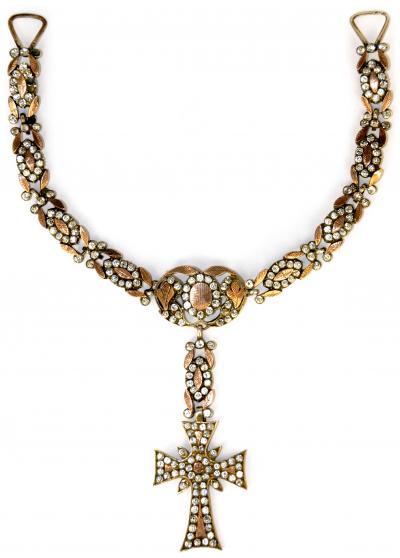
Yvetot necklace, silver and Rhinestones
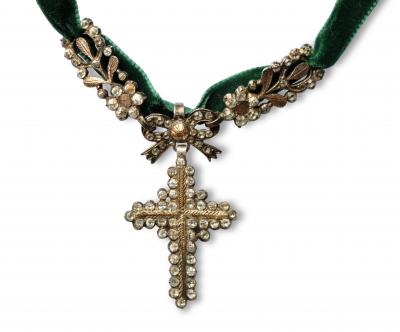
Yvetot necklace, silver and Rhinestones
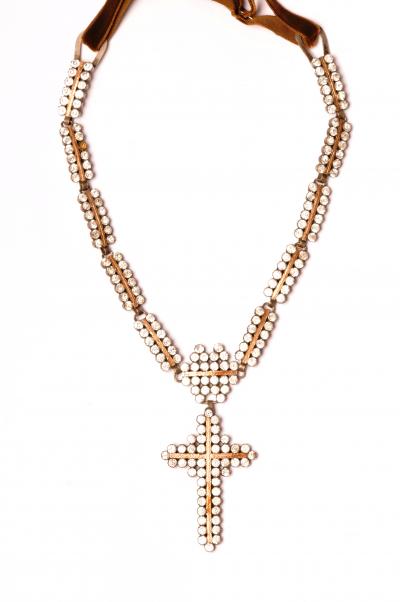
Yvetot necklace, silver and Rhinestones
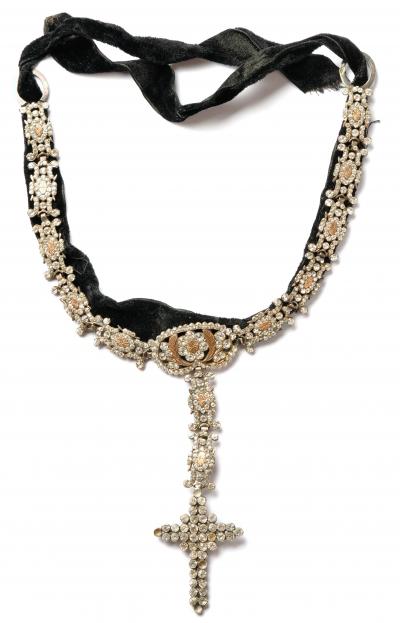
Yvetot necklace, silver and Rhinestones
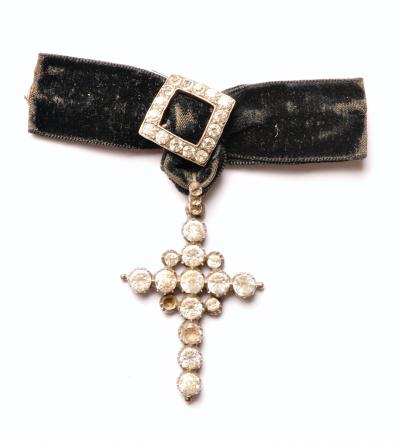
Yvetot cross in silver and Rhinestones
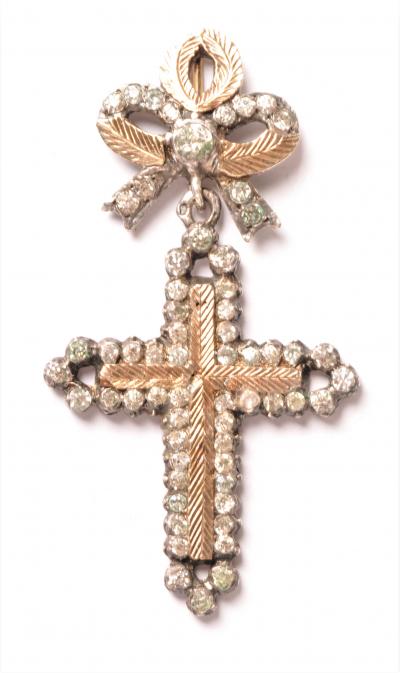
Yvetot cross, silver and Rhinestones |
|
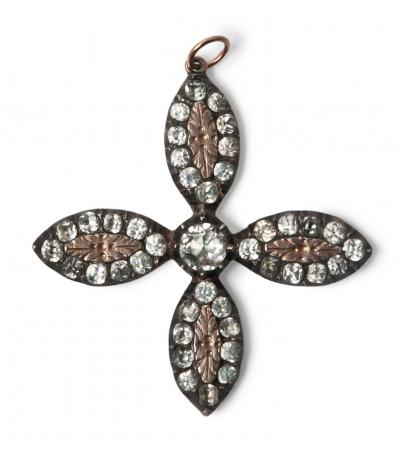
Yvetot cross, silver and Rhinestones |
|
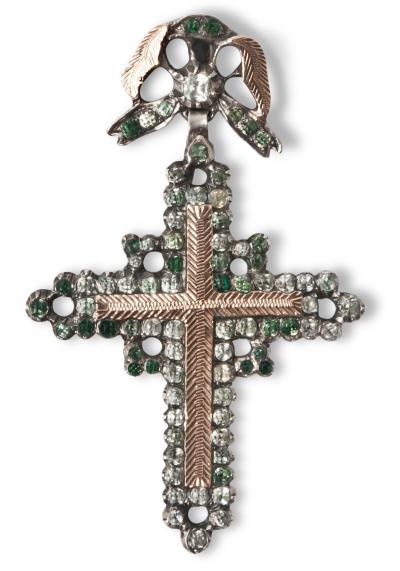
Yvetot cross, silver and Rhinestone |
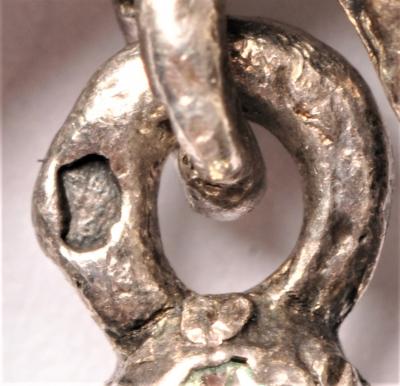
hallmark boar's head (Paris)
Pendants
Holy Spirit pendant
These Holy Spirit pendants, typical of Normandy, have a design of a dove flying towards the ground and holding an olive branch or, more rarely, a bunch of grapes in its beak. We sometimes see other smaller birds pecking at the olives or grapes. These pendants were generally made in silver set with strass, more rarely in gold. The earlier Holy Spirit pendants were quite simple, in silver set with a few Rhinestones, however they rapidly evolved into large elaborate pendants set with over a hundred Rhinestones. Some historians suggest that the Holy Spirit pendants were worn by Prostestants and the crosses by Catholics, others say that this isn't true. Today, it seems impossible to know which version is true. Note the evolotion of these pendants: they started out as a dove hanging from a knotted bow and then grandually became more and more decorated, however the bow motif always remained, almost hidden in some designs.
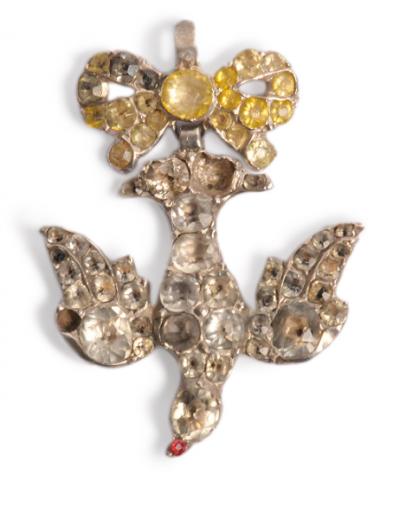
Holy Sprit pendant, silver and Rhinestones |
|
|
|
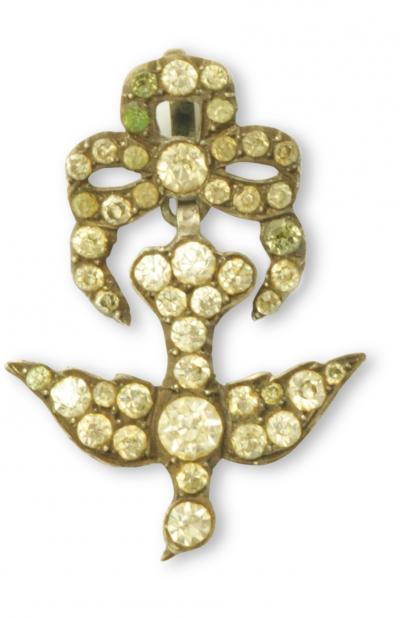
Holy Sprit pendant, silver and Rhinestones |
Holy Sprit pendants, silver and Rhinestones
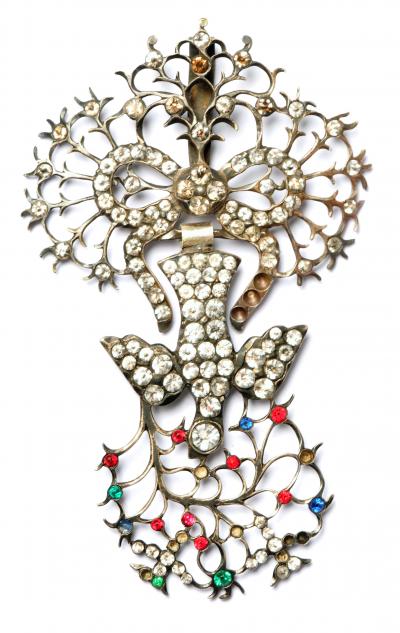
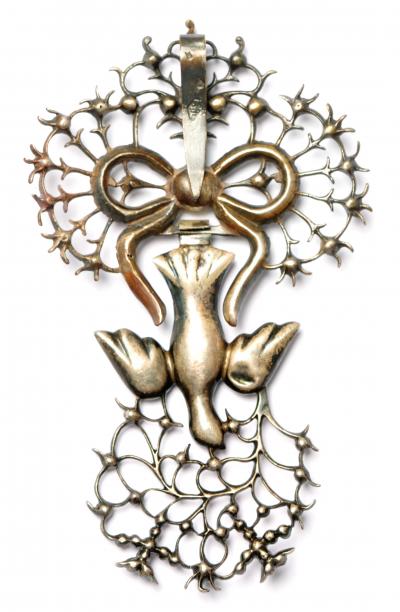
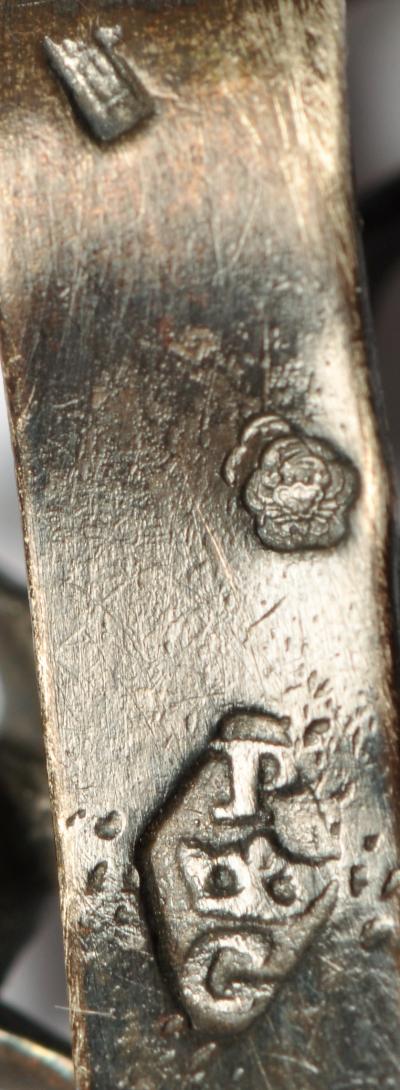
Holy Sprit pendant, front and back view, silver and Rhinestones
bijoux normands anciens
Saint Esprit normand en argent et stra
|
|
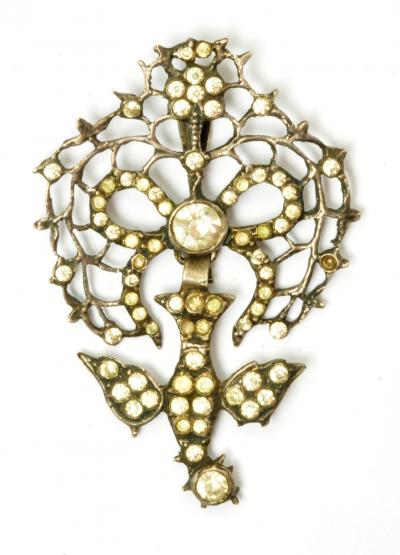
Holy Spirit pendant from Normandy, silver and Rhinestones
|
|
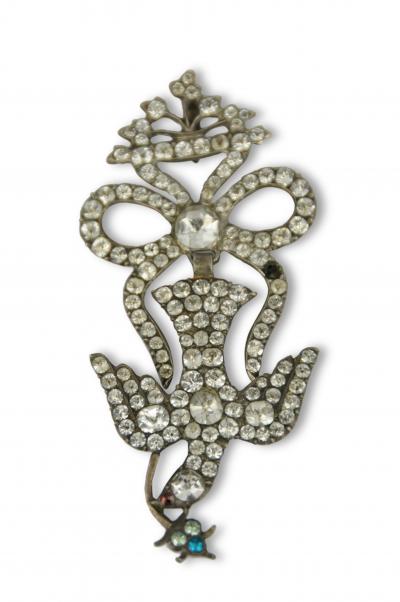
Holy Spirit pendant from Normandy, silver and Rhinestones
|
|
bijoux normands anciens
Saint Esprit normand en argent et strass
|
|
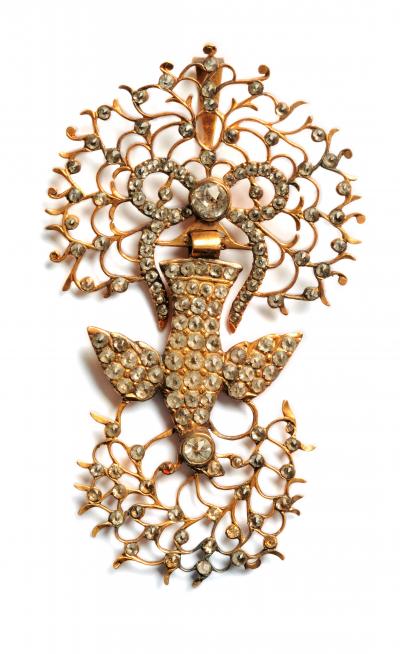
Holy Spirit pendant from Normandy
in gold and Rhinestones, recto |
|
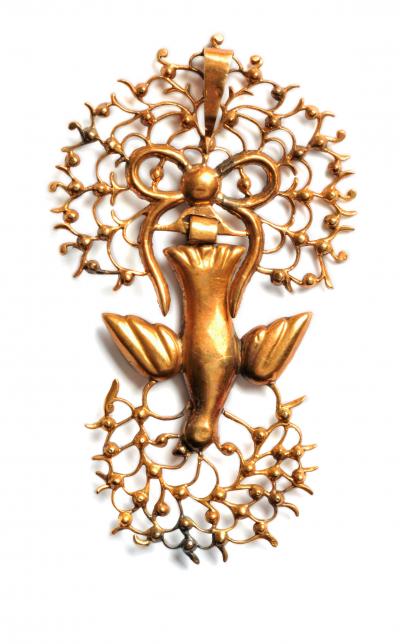
Holy Spirit pendant from Normandy
in gold and Rhinestones, verso |
|
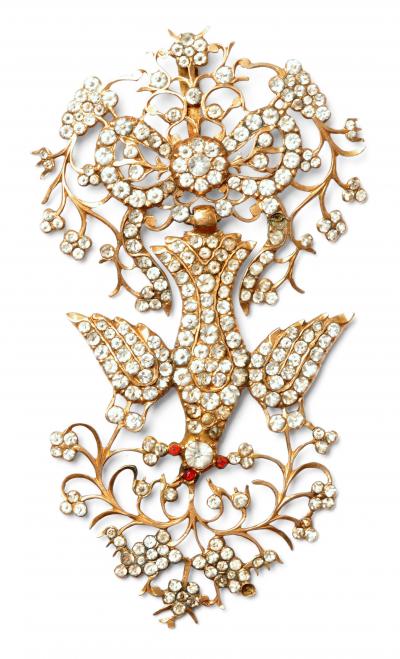
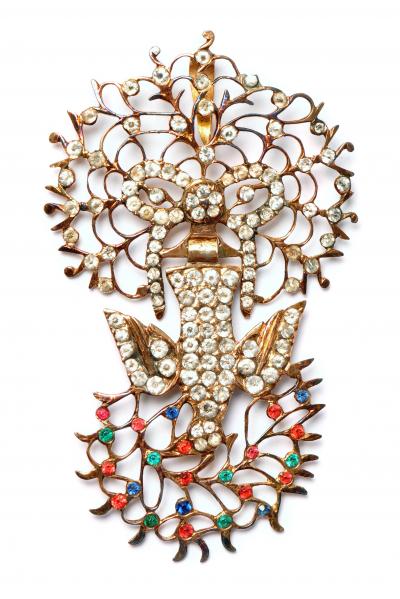
Two Holy Spirit pendants from Normandy in gold and Rhinestones
|
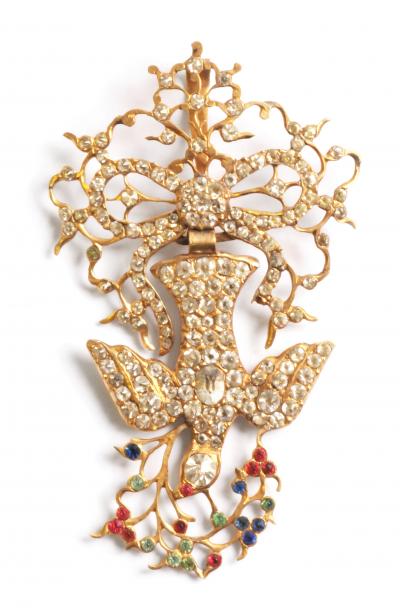
Holy Spirit pendant from Normandy
in gold and Rhinestones
|
|
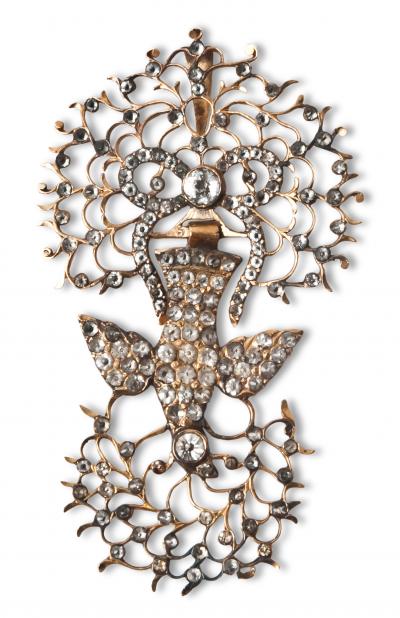
Holy Spirit pendant from Normandy
in silver and Rhinestones
|
|
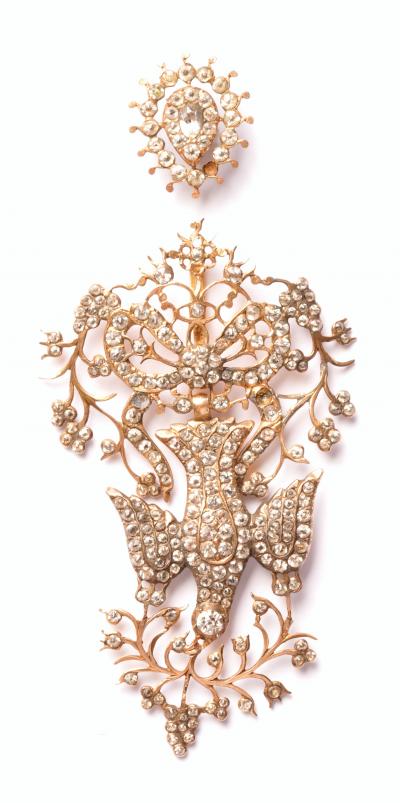
Holy Spirit pendant from Normandy
with its slide in gold and Rhinestones
|

Holy Spirit pendant from Normandy in gold and Rhinestones |

Holy Spirit pendant from Normandy in silver and Rhinestones
|
|
|
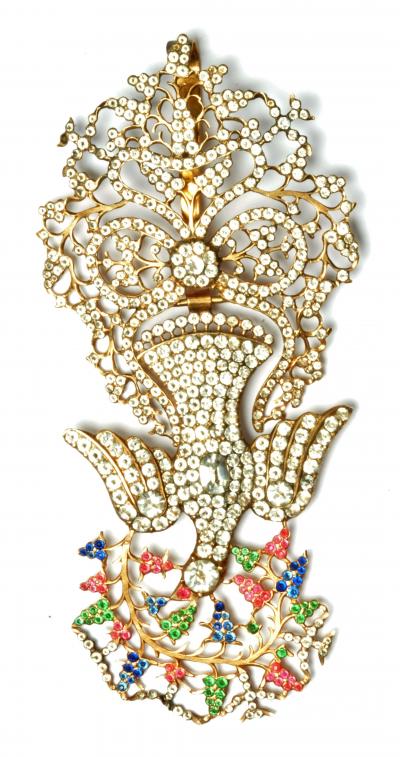
very large Holy Spirit pendant, Normandy, gold and Rhinestones
front view
|
|
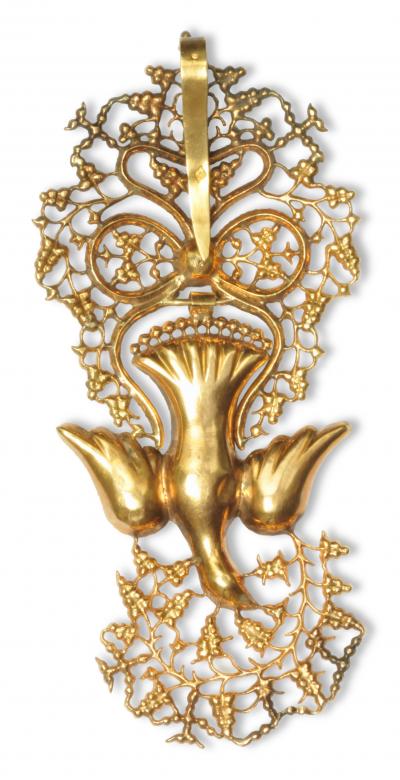
very large Holy Spirit pendant, Normandy, gold and Rhinestones
reverse view
|
|
click on the photos to enlarge them in high resolution
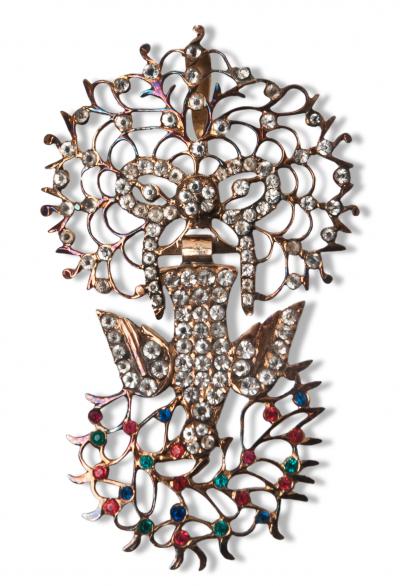
Holy Spirit pendant, Normandy,
gold and Rhinestones |
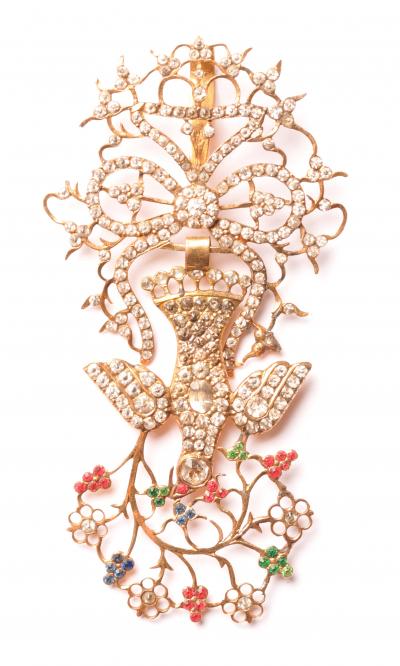
Holy Spirit pendant, Normandy,
gold and Rhinestones |
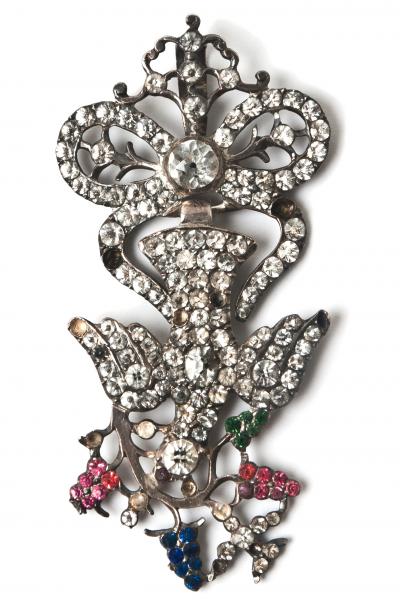
Holy Spirit pendant, Normandy,
silver and Rhinestones |
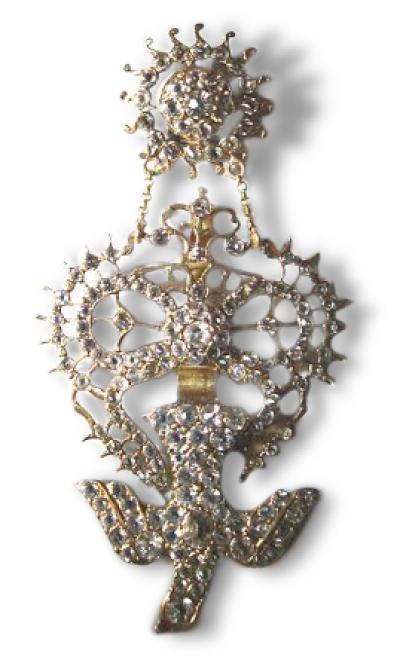
Holy Spirit pendant, Normandy,
gold and Rhinestones 1809-1819 |
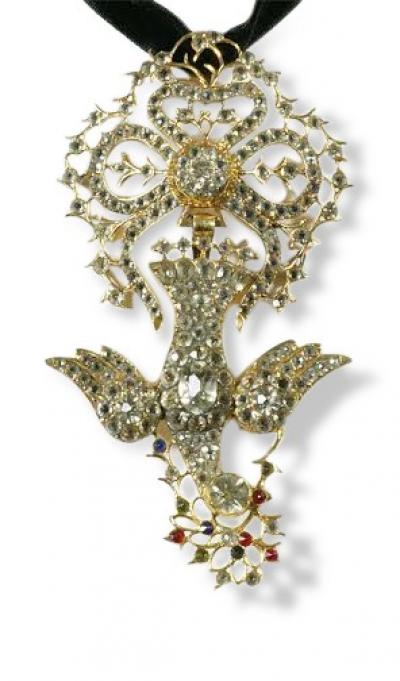
Holy Spirit pendant,
Normandy, gold and Rhinestones
|
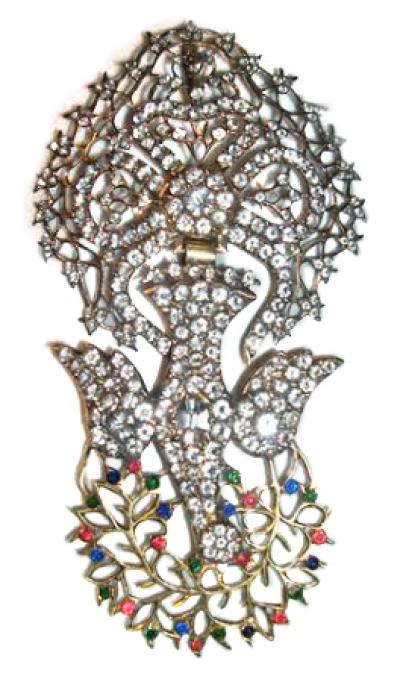
Holy Spirit pendant, Normandy,
silver and Rhinestones, 1809-1819 |
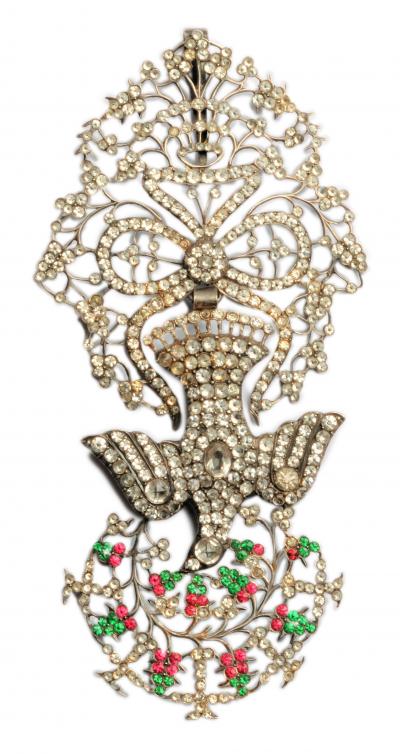
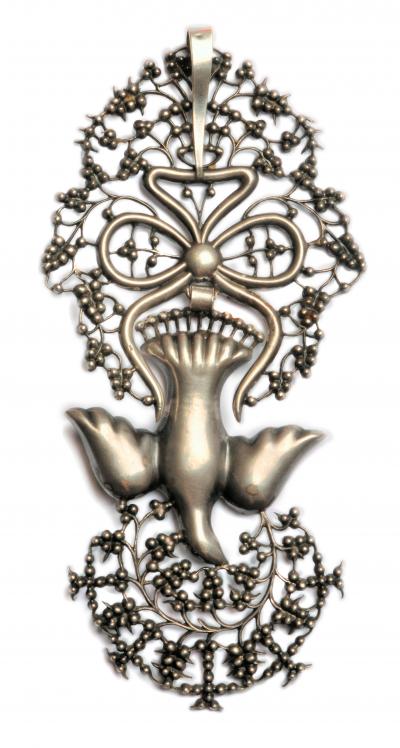
Very large Holy Spirit pendant (130mm) from Normandy in silver and Rhinestones
Vlaamse Hart pendant
Vlaamse Hart pendants originated in Antwerp at the end of the eighteenth century and are made in gold-backed silver set with rose-cut diamonds. The majority were produced between 1800 and 1850. Of the 38 examples in the treasury of the Antwerp churches, 10 have no hallmarks, 6 are from southern Belgium during the Dutch rule, 14 from Mechelen, 7 from Antwerp and one from Ghent. The name translates to “Flemish heart” and they represent the heart of Mary. There are two types of Vlaamse hart pendants; one has a simple wreath set above the lower half, see left-hand photo, while the other, which was offered as a love token, is crowned with a bow and a quiver, a flaming torch and some foliage. They were worn frequently in the north of France and one still finds them in Normandy as well. It should be remembered that Belgium was a French province between 1793 and 1815. 1
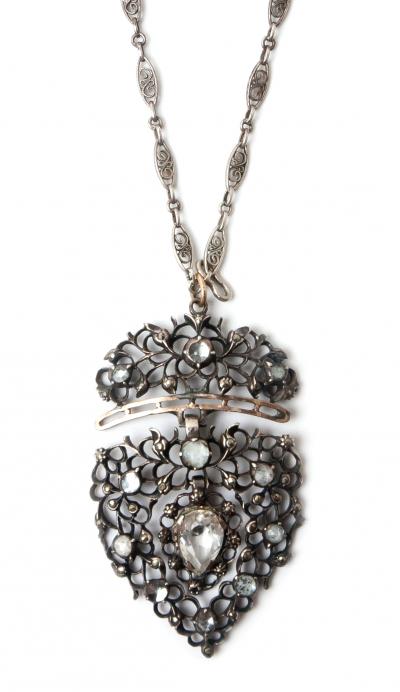
"Vlaamse hart" pendant in gold-backed silver
and diamonds |
|
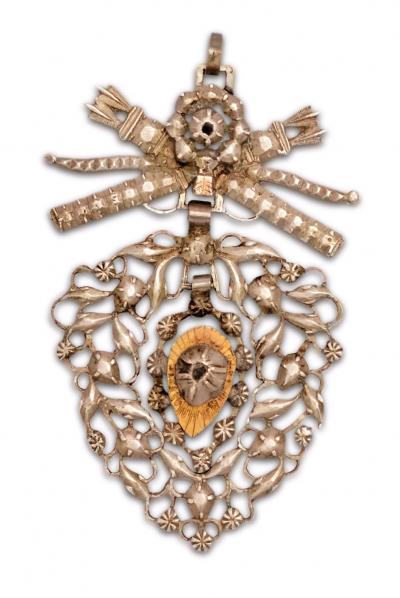
"Vlaamse hart" pendant in gold-backed silver
and diamonds |
|
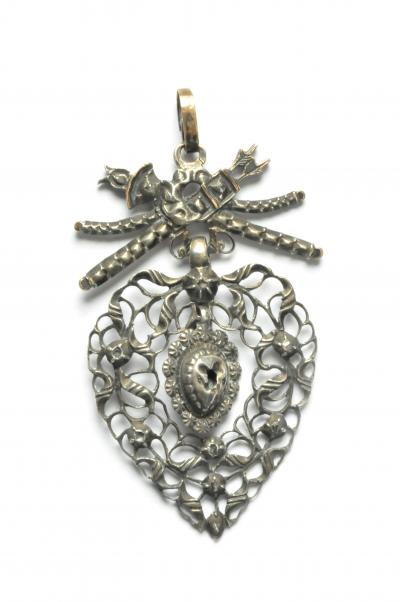
"Vlaamse hart" pendant in gold-backed silver
and diamonds (central diamond missing) |
|
|
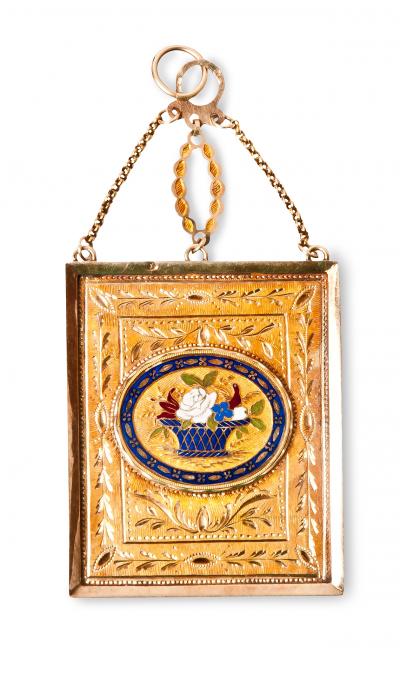
gold and enamel pendant from Normandy
sometimes suspended from a slave necklace (see example in necklace section), generally worn alone, these pendants are found only in Normandy
|
|
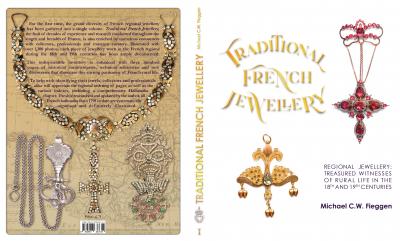
Book - Traditional French Jewellery - order here direct from the author

(1) MASSON SAINT-AMAND, Armand Claude, Mémoire statistique du département de l'Eure, adressé au ministre de l'Intérieur d'après ses instructions par M. Masson Saint-Amand, préfet de ce département, publié par ordre du gouvernement. A Paris, de l'imprimerie impériale, an XIII (rapport basé sur des observations faits en 1801, publié en 1805)
(2) POULENC, Monique & MARGERIE, Anne-Michèle., Les bijoux traditionnels français, Musée des arts et traditions populaires, RMN, 2005
(3) PERRY, Jane., The Victorian passion for peasant jewellery, Jewellery studies, volume 12, 2012
(4) BOURET, Brigitte., Bijoux et orfèvres en Haute Normandie au XIX siècle, Musées départementaux de Seine Maritime, 1993
(5) BRUNEAU, Marguerite., Histoire du costume populaire en Normandie, Cercle d'action et d'études normandes, 1983
contents:
bijoux normands - bijoux et orfevres en haute Normandie - croix de Saint Lô - croix de Rouen - croix de Caen - croix drille - croix cde Pierres - Saint Esprit normand - croix de Dieppe - ivoire de Dieppe - croix bosse - épingle de coiffe - croix papillon - croix à la Jeannette - ivoire de Dieppe - collier d'esclavage - pendants d'oreille fileuses - poissardes - croix d'Yvetot - agrafe de cape - vlamse haart - Lanté et Gatine - croix de Boulogne - boucles d'oreilles Milanos - pendants d'oreilles Milanos - bague Lisbonne - bague noeud d'amour - chaine sorcière - croix de pardon - bijoux boulonnais - coiffe soleil - costume de matelotte - bague capelet - croix de Champagne - croix d'Alsace - broche alsacienne - croix de Lorraine - bijoux des régions de France - les bijoux des Français - les bijoux de France - bijoux régionaux - bijou régional - croix écotée - pendentif Saint Esprit - Saint Esprit d'Aurillac - rose de Velay - collier d'esclavage - croix de Puy en Velay - croix d'Auvergne - bijoux d'Auvergne - bijoux auvergnat - collier Saint Esprit de Puy en Velay - croix de Velay - bijoux d'Auvergne et du Velay - costume regional - bijoux régionaux - coiffe - coiffe auvergnat - bijoux des régions de France - bijoux régionaux - les bijoux traditionnels Français - croix régionales - Léon Giron - Antoine Raspal - Thomas Desgeorge - Estella Canziani - esclavage auvergnat - French regional jewellery – jewelry - French traditional jewellery – jewelry - French folk-dress - French folk costumes - antique French jewellery - les bijoux de France - les bijoux des Français - Streeksieraden en Zeeland Friesland - Vlaamse Hart
French regional jewellery - Normandy
New book - Traditional French Jewellery

Book - Traditional French Jewellery - order here direct from the author
Dear collectors, auctioneers, dealers and jewellery lovers,
You have visited the site www.bijouxregionaux.com which for twelve years now has listed all regional and traditional French jewellery, without advertising and without sales. By popular demand, this website is now finally available as a book, much more complete and with many new photos and texts that are not on the site. I traveled more than 4,500 km in 2020 to visit the various collectors and museums of France and to photograph, weigh, measure and examine their jewellery.
Large format of 23.5 x 30 cm, 304 pages, hardcover and fully illustrated with over 1300 jewels in color, this book is the first complete book on French regional jewellery and corrects the many errors and gaps observed in the other references and presents other regional jewels hitherto unknown to the public. You will find eight full pages on Breton pins and fibulae and many other jewels in museums and private collections that are not on this website. Over four months of research has gone into making the chapter on hallmarks the most reliable ever seen - clear illustrations of hallmarks have been made especially for this volume. And for the first time, collectors will have access to a complete list of all the assay office symbols, small signs withn the hallmarks that identify in which city the jewellery was hallmarked. The opening and closing dates since 1798 of the hallmark offices are also listed for the first time, allowing, with the office symbol, to better date your jewellery.
The print run of this book is very limited, which is why I recommend you order early. You will love this book I have had nothing but compliments and many clients have ordered more to offer as gifts.
To order, you can send a wire transfer or WISE transfer to Michael Fieggen - FR76 4061 8803 9700 0403 3233 171 – BIC – BOUSFRPPXXX - address Mike Fieggen, 280 rue Saint Honoré, Paris, 75001 France
Bank or wire transfer by www.wise.com in Sterling – Account holder - Michael Fieggen
IBAN - GB68TSBS30916200184462 BIC / SWIFT - TSBSGB2AXXX
Sterling cheques and PayPal welcome to address demosthenesparis@gmail.com.
Any questions ? Contact me at bijouregional@gmail.com or by telephone at + 33 1 4015 9000
One copy in French €75 Postage and packing €9 for France, €8 for Europe and overseas
Two or more copies in French €75 each Postage and packing €9 for the lot in France, overseas postage €8 each
One or more copies in English £75 sterling each Postage and packing £8 sterling each




















































































